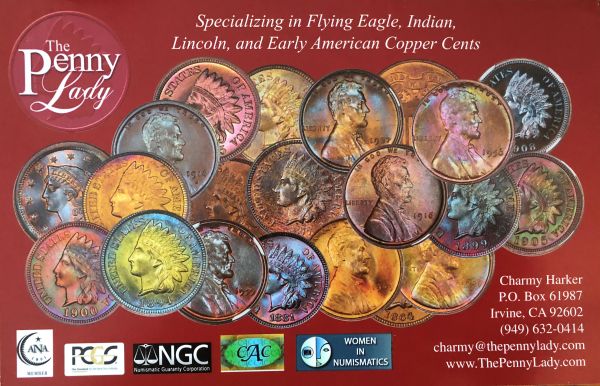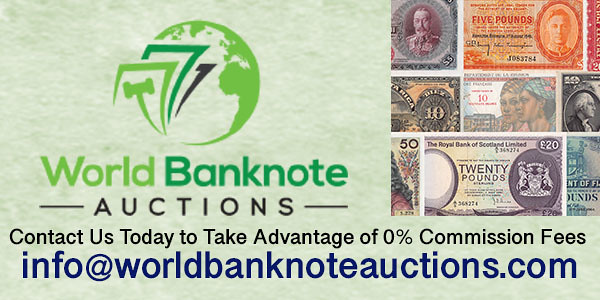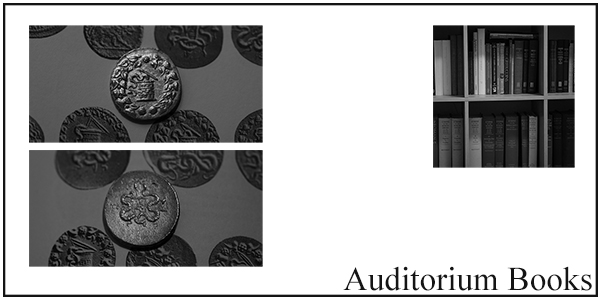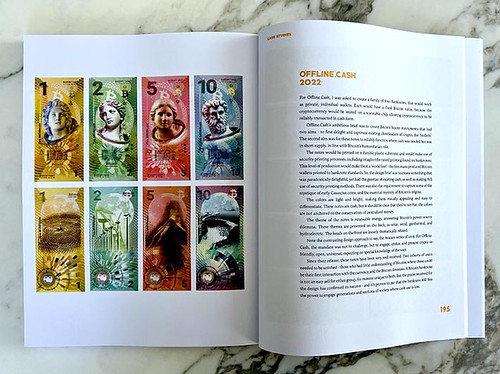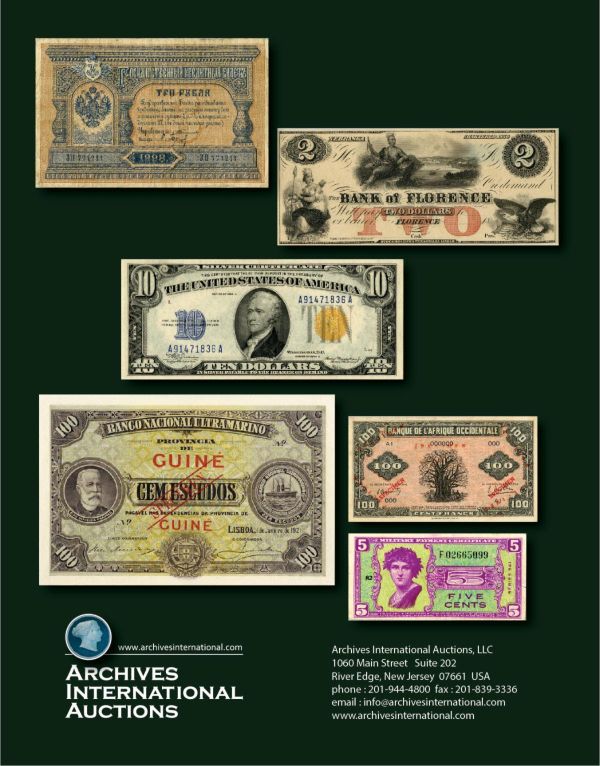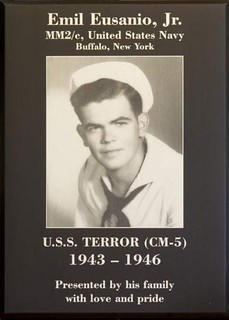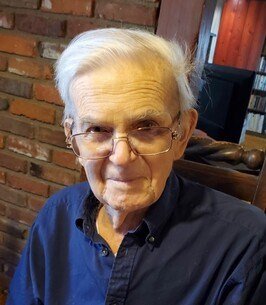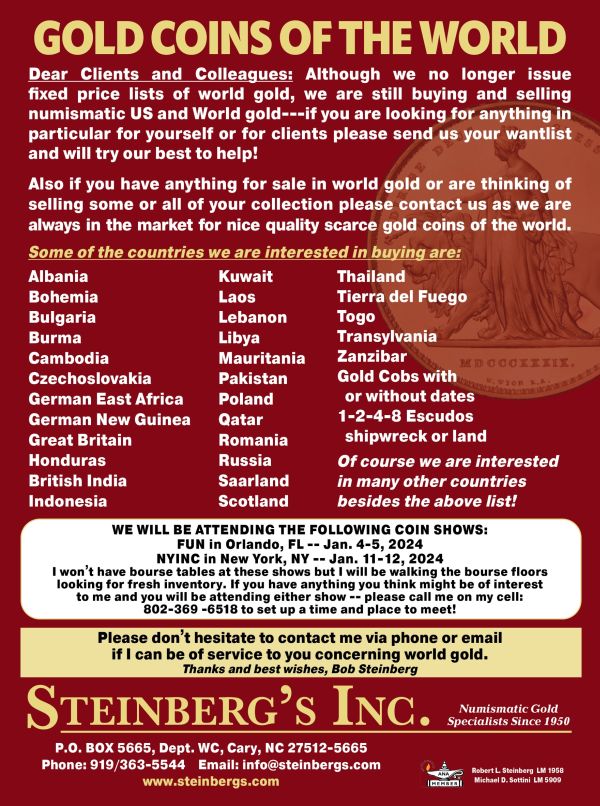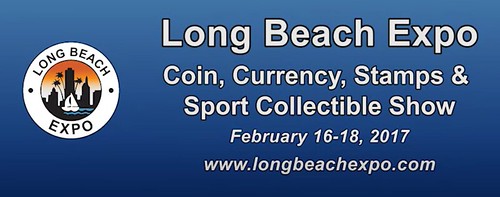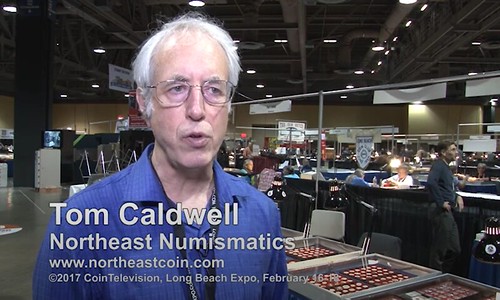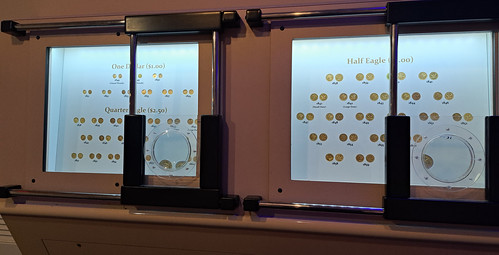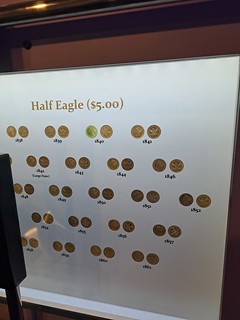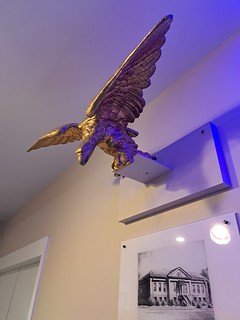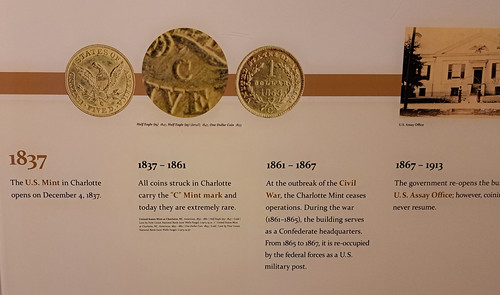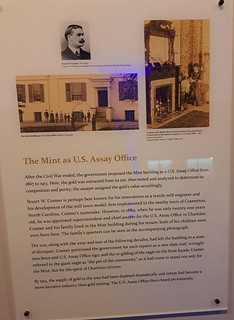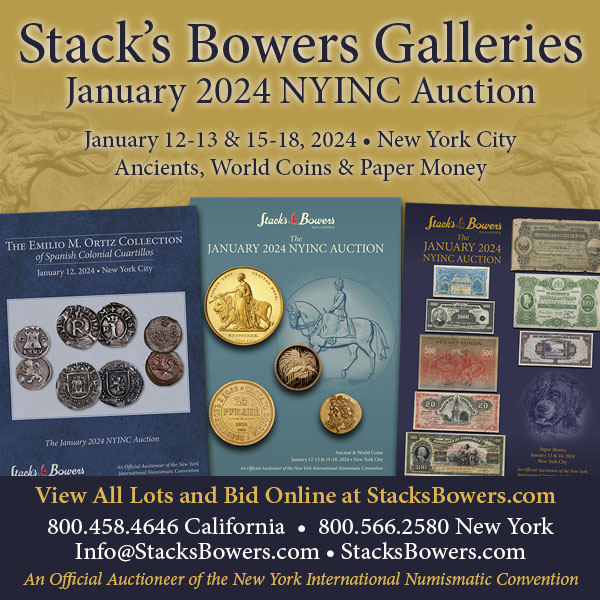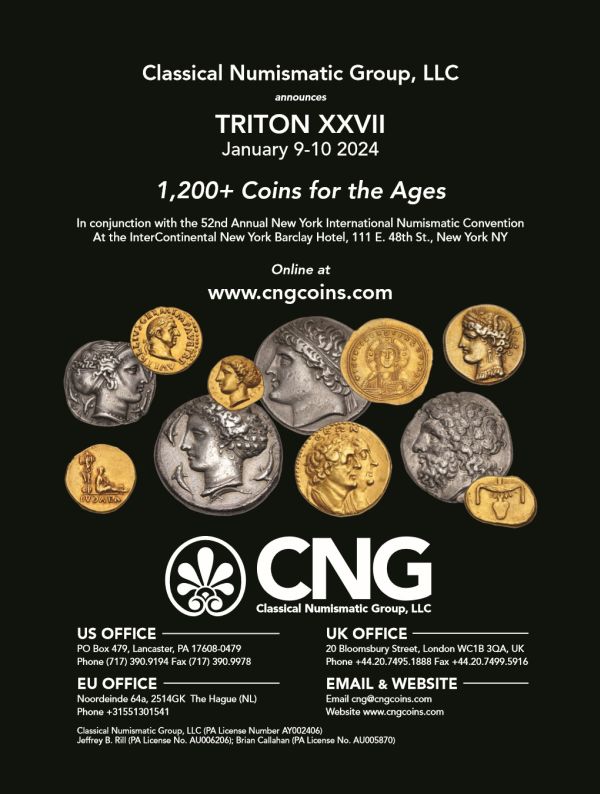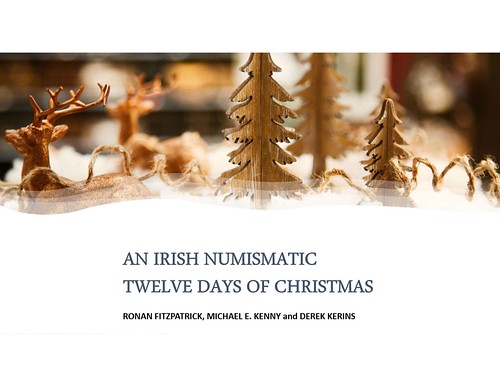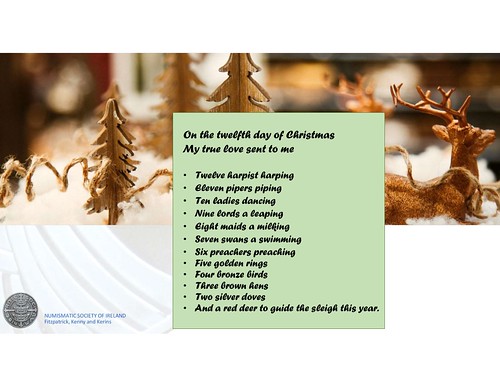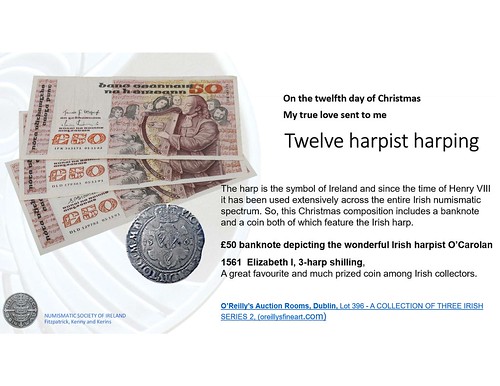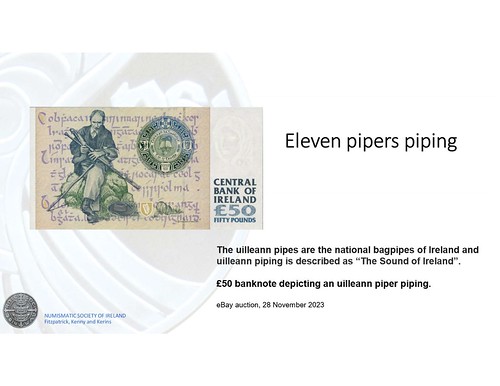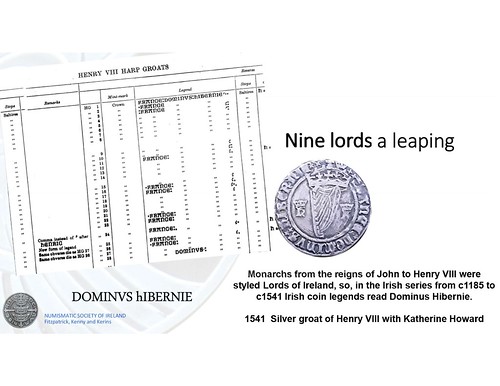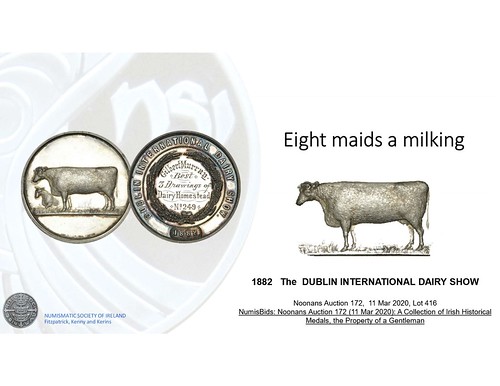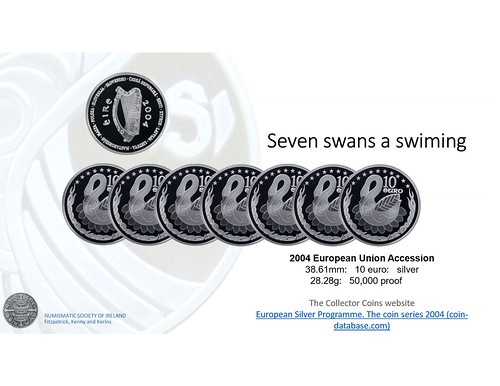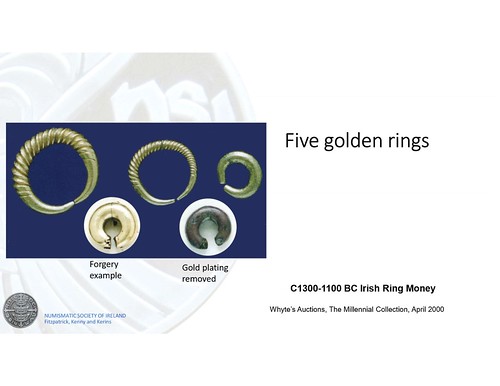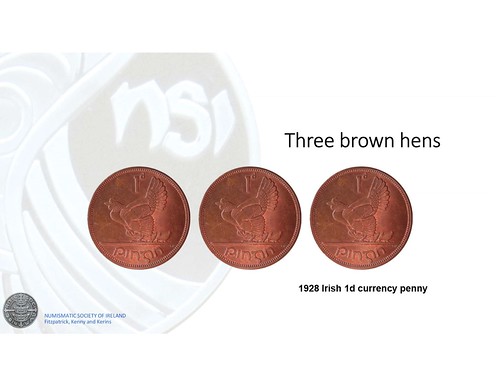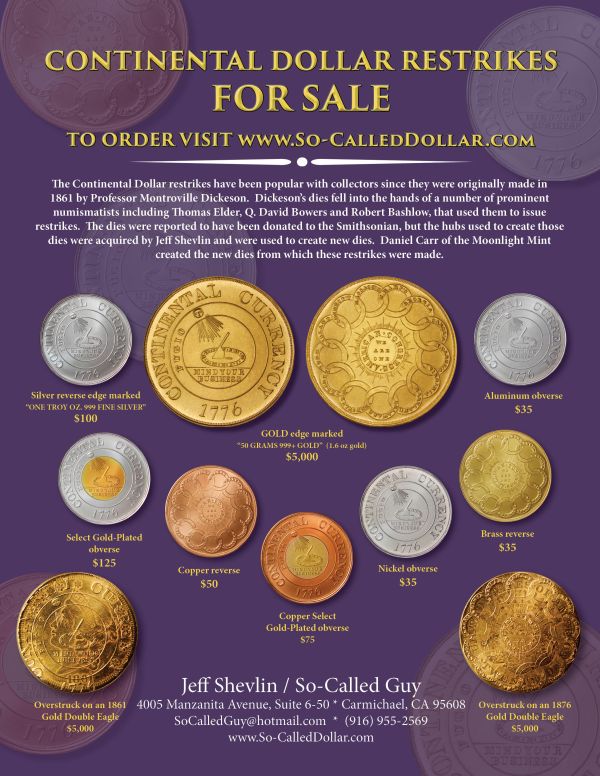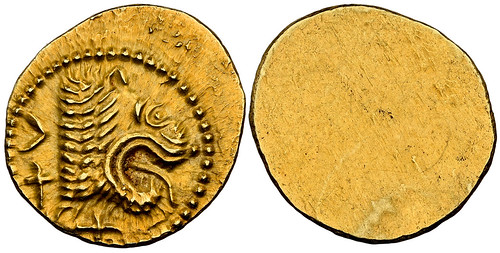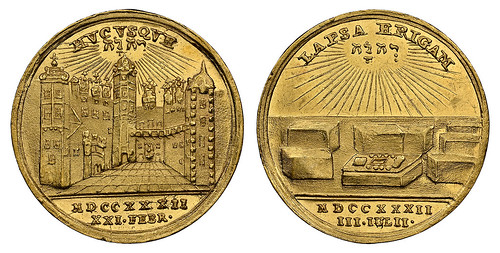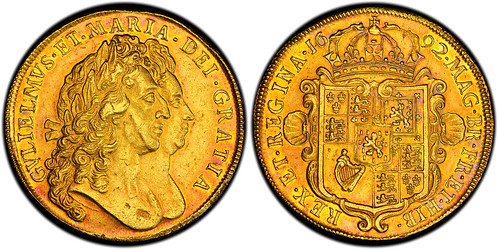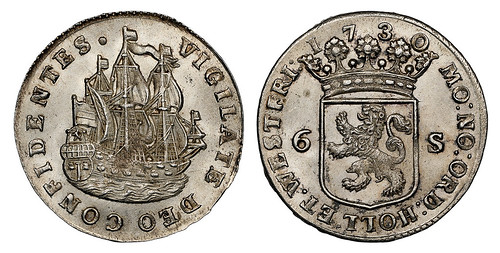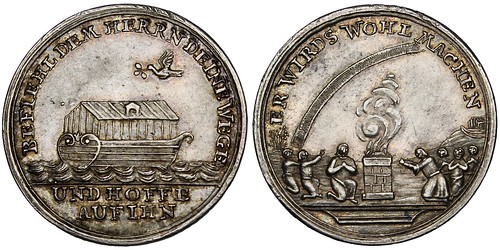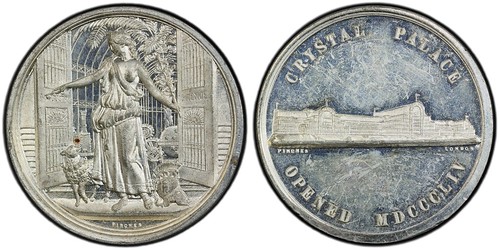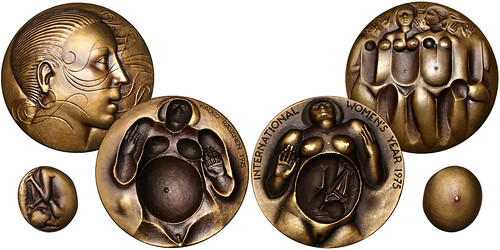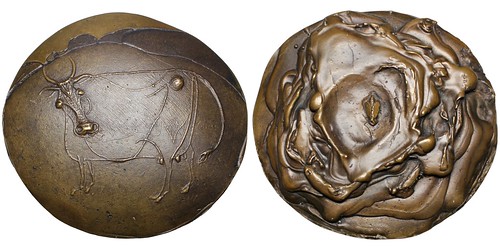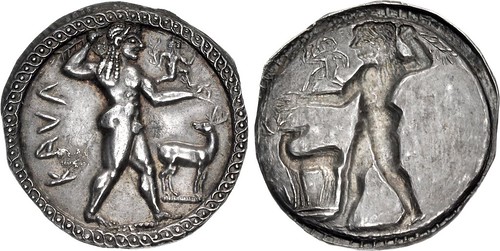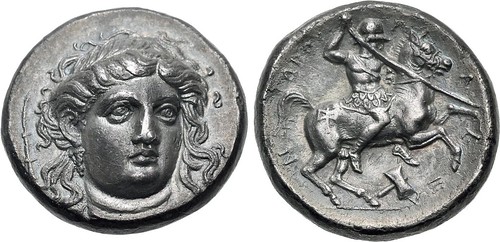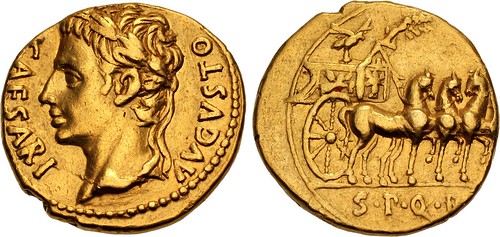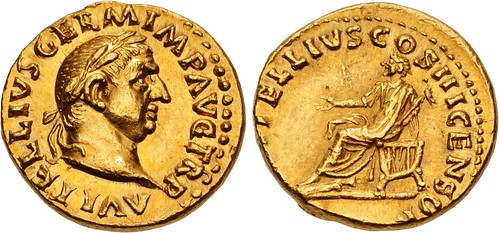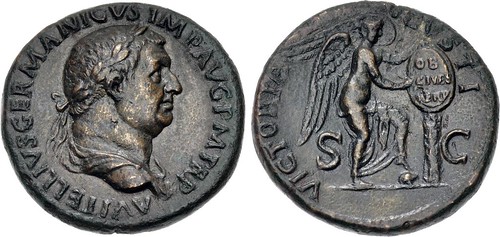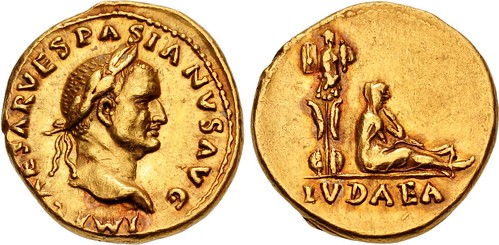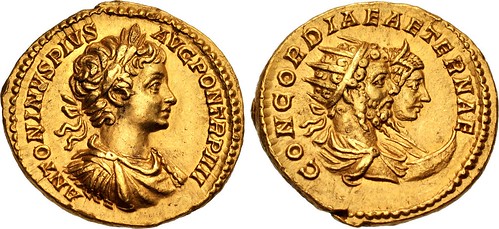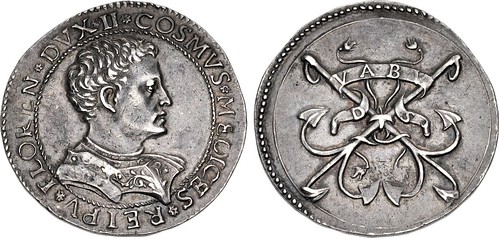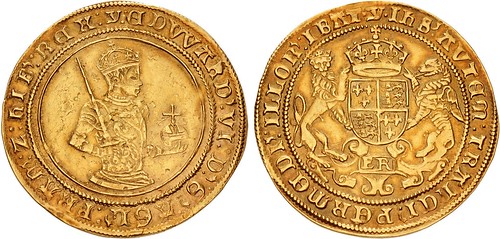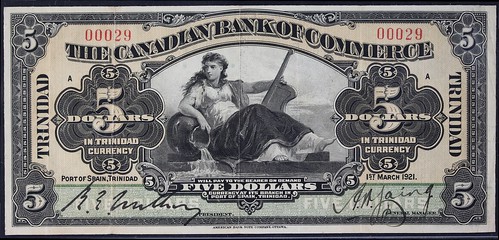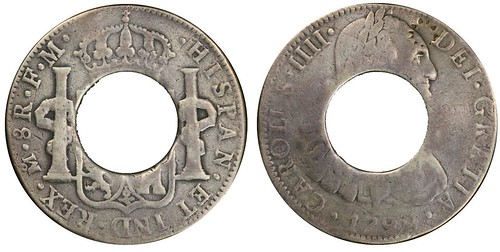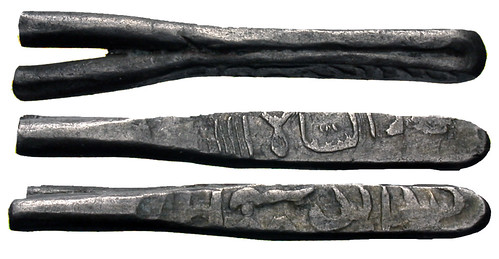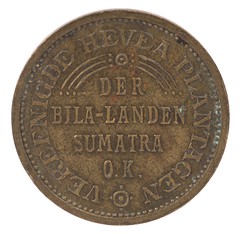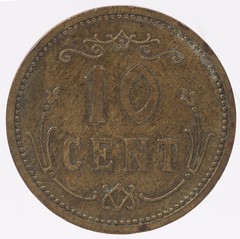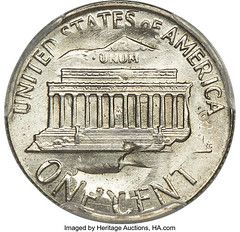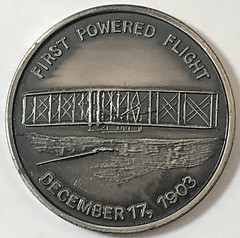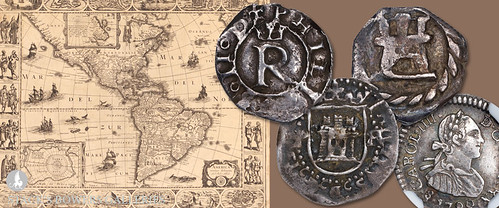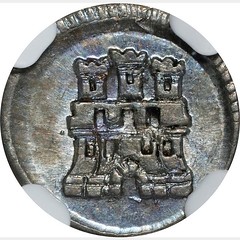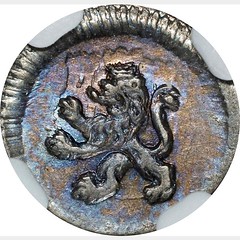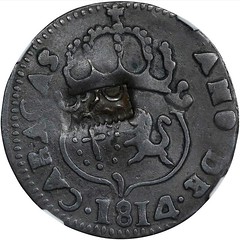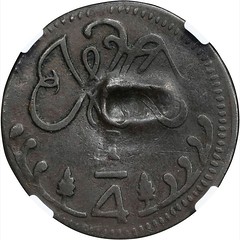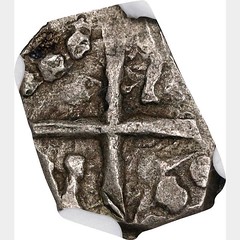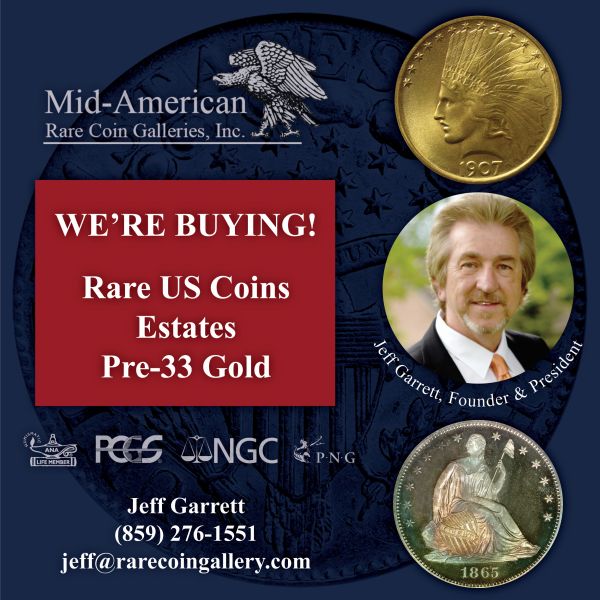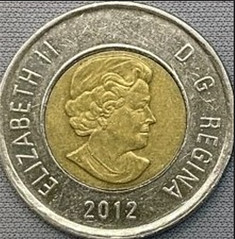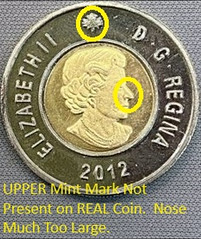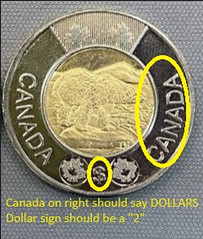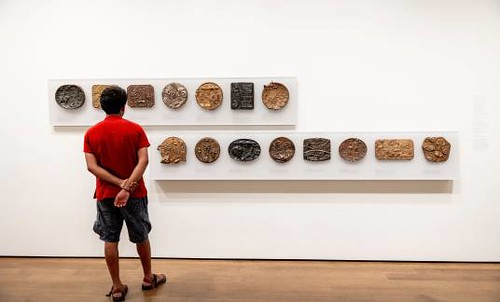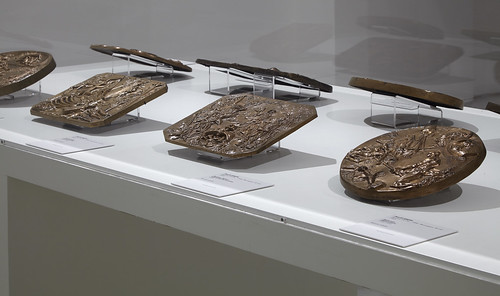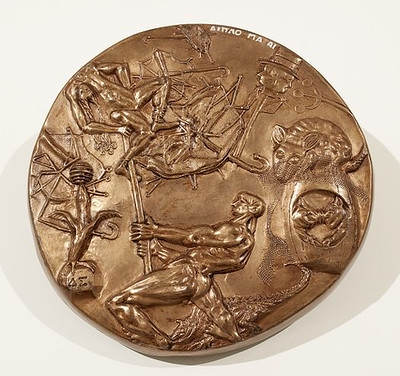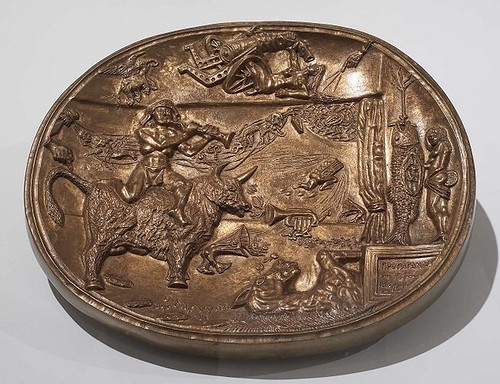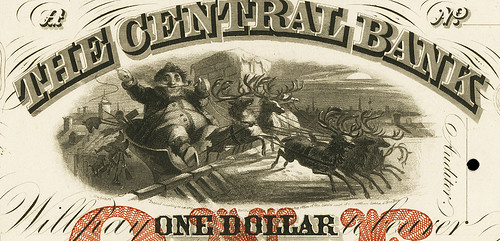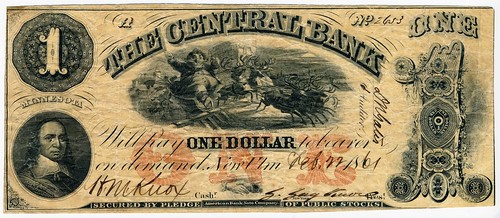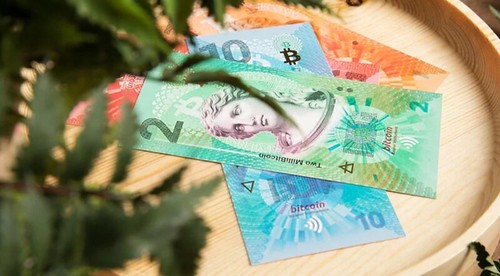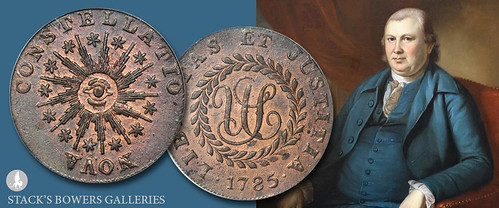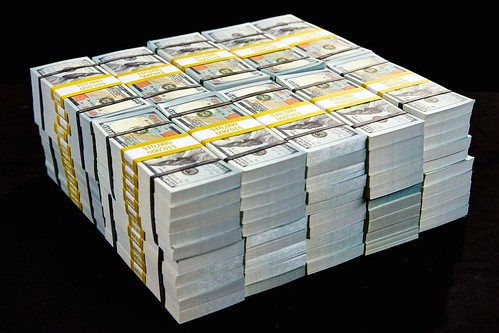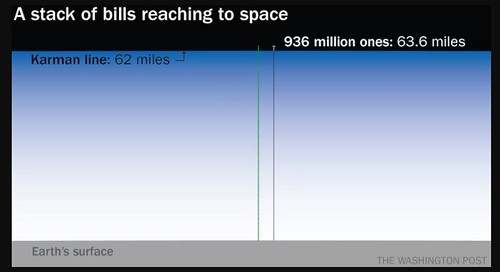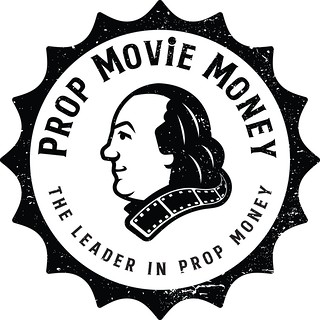
Visit our NBS Sponsors
About UsThe Numismatic Bibliomania Society is a non-profit association devoted to the study and enjoyment of numismatic literature. For more information please see our web site at coinbooks.org SubscriptionsThose wishing to become new E-Sylum subscribers (or wishing to Unsubscribe) can go to the following web page link MembershipThere is a membership application available on the web site Membership Application To join, print the application and return it with your check to the address printed on the application. Print/Digital membership is $40 to addresses in the U.S., and $60 elsewhere. A digital-only membership is available for $25. For those without web access, write to: Jeff Dickerson, Treasurer AsylumFor Asylum mailing address changes and other membership questions, contact Jeff at this email address: treasurer@coinbooks.org SubmissionsTo submit items for publication in The E-Sylum, write to the Editor at this address: whomren@gmail.com BUY THE BOOK BEFORE THE COINSale Calendar |
- WAYNE'S WORDS: THE E-SYLUM DECEMBER 17, 2023
- NEW BOOK: ROMAN IMPERIAL COINAGE V.4 GALLIC EMPIRE
- NEW BOOK: GOLD COINS OF THE WORLD, 10TH ED
- NEW BOOK: MEDALS FOR DISHONOR
- NEW BOOK: ART & MONEY
- NEW BOOK: GUIDE TO BECOMING A COIN DEALER
- EMIL NICHOLAS EUSANIO (~1925-2022)
- BOB LYALL (1938-2023)
- CHRISTMAS RIDDLES & THE COIN COLLECTOR
- VIDEO: FEBRUARY 2017 LONG BEACH EXPO
- CHARLOTTE MINT MUSEUM COIN EXHIBIT
- NOTES FROM E-SYLUM READERS: DECEMBER 17, 2023
- THE PROOF COIN IS IN THE PUDDING!
- AN IRISH NUMISMATIC TWELVE DAYS OF CHRISTMAS
- VOCABULARY TERMS: OVERLETTER, OVERLETTERING
- THE BOSTON STAMP HEISTS
- NATIONAL SILVER DOLLAR ROUND TABLE ESSAY
- ATLAS NUMISMATICS SELECTIONS: DECEMBER 17, 2023
- NUMISMAGRAM MEDAL SELECTIONS: DECEMBER 17, 2023
- CNG TRITON XXVII SALE
- TCNC JANUARY 2024 NEW YEAR'S SALE
- NUMISMATIC NUGGETS: DECEMBER 17, 2023
- SPANISH COLONIAL CUARTILLOS
- AUSTRALIA RELEASES NEW $1 KING CHARLES COIN
- REALLY BAD FAKE CANADIAN TOONIES
- DAVID SMITH'S MEDALS FOR DISHONOR
- MORE ON MEDALS FOR DISHONOR
- JELONEK AWARDED WACKS JUDAICA ART MEDAL
- THAT'S NOT SANTA CLAUS
- TOM BADLEY'S BITCOIN BANKNOTES
- LOOSE CHANGE: DECEMBER 17, 2023
- MONEY MEASUREMENT MANIA
- FEATURED WEBSITE: PROP MOVIE MONEY
Content presented in The E-Sylum is not necessarily researched or independently fact-checked, and views expressed do not necessarily represent those of the Numismatic Bibliomania Society.
WAYNE'S WORDS: THE E-SYLUM DECEMBER 17, 2023
 Thank you for reading The E-Sylum. If you enjoy it, please send me the email addresses of friends you think may enjoy it as well and I'll send them a subscription. Contact me at whomren@gmail.com anytime regarding your subscription, or questions, comments or suggestions about our content.
Thank you for reading The E-Sylum. If you enjoy it, please send me the email addresses of friends you think may enjoy it as well and I'll send them a subscription. Contact me at whomren@gmail.com anytime regarding your subscription, or questions, comments or suggestions about our content.
We currently send two versions of the email each week. One is the regular long version, and the other is a very short one with a link to the complete version online. Some email providers (AOL, Yahoo) don't like the long version. The short version seems to get through to everyone, and next year we may stop sending the long one to reduce clutter and confusion. If you're getting both versions but haven't tried using the short one, please do so and let us know if you have any problems.
Also, since the upcoming issue dates fall on Christmas and New Year's Eve, we'll likely not publish Sunday night as usual but sometime the following day or so. Happy holidays!
This week we open with five new books, two passings, updates from the Newman Numismatic Portal, notes from readers, Christmas collectibles, and more.
Other topics this week include Roman Imperial Coinage, the Charlotte Mint Museum, overlettering, fixed price and auction previews, King Charles coins, dodgy toonies, medals for dishonor, St. Nicholas, bitcoin banknotes, and movie prop money.
To learn more about how to become a coin dealer, the San Fernando Book Co., Bob Lyall, Santa's helpers, sickly coins, Christmas puddings, the Boston Stamp Heists, useless papers, documents, and records, Persian hairpin money, a huge silver pentakaidekadrachm, and the rebel Queen Zenobia of Palmyra, read on. Have a great week, everyone!
Wayne Homren
Editor, The E-Sylum
NEW BOOK: ROMAN IMPERIAL COINAGE V.4 GALLIC EMPIRE
Spink has published a new volume in the Roman Imperial Coinage series, covering the Gallic Empire from AD 260-274. -Editor
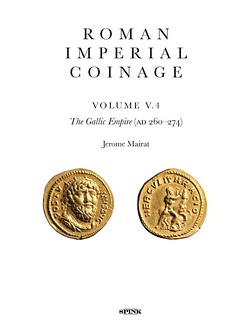 Roman Imperial Coinage Volume V.4: The Gallic Empire
Roman Imperial Coinage Volume V.4: The Gallic Empire
by Jerome Mairat
Regular price £150.00
276 x 219mm, 404 pages
The Roman Imperial Coinage (abbreviated RIC) is a typological catalogue of Roman Imperial coins from the Battle of Actium in 31 BC to Late Antiquity in 491 AD. It aims to offer a complete and chronological reconstruction of the whole coinage produced by each of the Roman emperors. The series was started in 1923, and has become the standard work for numismatic reference. It was previously comprised of 10 volumes in 13 parts, some of which are currently being revised and will be divided differently.
This brand new volume, published to celebrate the centenary of the series, covers the Gallic Empire from AD 260-274.
Jerome Mairat is the Curator of Roman Coins at the Ashmolean Museum and Lecturer in Roman Numismatics at the Faculty of Classics, University of Oxford. He holds the positions of Director for RPC Online and General Editor for the Roman Provincial Coinage series, having authored several volumes. His research is primarily focused on the third century coinage, both imperial and provincial.
For more information, or to order, see:
Roman Imperial Coinage Volume V.4: The Gallic Empire by Jerome Mairat
(https://spinkbooks.com/products/roman-imperial-coinage-volume-v-4-the-gallic-empire-by-jerome-mairat)
NEW BOOK: GOLD COINS OF THE WORLD, 10TH ED
Coin & Currency Institute has published a new edition of Friedberg's Gold Coins of the World. -Editor
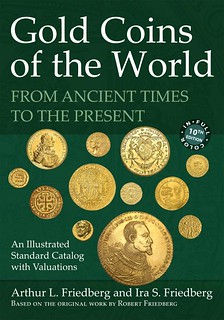 The last edition of Gold Coins of the World, by Arthur L. Friedberg and Ira S. Friedberg, was published by the Coin & Currency Institute six years ago, in 2017. That edition the ninth and each one before are derived from the original, groundbreaking 1958 work by Robert Friedberg, whose cataloging and numbering system revolutionized the way gold coins are collected. It changed the face of world-gold collecting at that time, and it remains unparalleled in its scope and universal usage today, six decades later. Collectors and dealers around the world rely on the Friedberg Numbering System™ to systematically identify and study any gold coin ever made. Now, the Friedberg legacy is renewed yet again with the all-new, tenth edition of Gold Coins of the World. Three years in the making, the newest edition calls on the expertise of a numismatic who's-who of more than one hundred expert contributors and consultants from across the globe.
The last edition of Gold Coins of the World, by Arthur L. Friedberg and Ira S. Friedberg, was published by the Coin & Currency Institute six years ago, in 2017. That edition the ninth and each one before are derived from the original, groundbreaking 1958 work by Robert Friedberg, whose cataloging and numbering system revolutionized the way gold coins are collected. It changed the face of world-gold collecting at that time, and it remains unparalleled in its scope and universal usage today, six decades later. Collectors and dealers around the world rely on the Friedberg Numbering System™ to systematically identify and study any gold coin ever made. Now, the Friedberg legacy is renewed yet again with the all-new, tenth edition of Gold Coins of the World. Three years in the making, the newest edition calls on the expertise of a numismatic who's-who of more than one hundred expert contributors and consultants from across the globe.
The continued respect commanded by each edition of the volume is due to the expertise of both the authors and the impressive contributors they bring together. The popularity of gold coins, however, is due to a whole host of factors. It is not an overstatement to say that the history of gold coinage parallels, and has helped define. the trajectory of civilization.
From the preface:
Since the first gold coins were struck in ancient Lydia, about 700 BC, they have been the subject of collecting, hoarding, accumulating, and investing. For over two and a half millennia, they, along with gold itself, have been man's ultimate measure of economic value. For rarity, purity, luster, resistance to the ravages of the elements and time, for unique color and for sheer beauty, they have nary a rival among the creations of either man or nature. In times of uncertainty and war, depression and panic, inflation. and disaster. they have served their purpose as symbols of security when all else lay in ruin.
More remarkable than the rise in the gold price is the dramatic, unparalleled, and sometimes frenzied increase in the value of numismatic gold coins. Collectors and investors now realize the relative rarity of coins compared not only to other forms of art and antiques but also to other numismatic categories. The tenth edition of Gold Coins of the World is arriving at just the right time to meet the needs of this ever-expanding market.
Like each edition before it, the tenth expands on its predecessor, digging more deeply into new areas of collector interest, and expanding many sections. It includes the addition of many new discoveries for dozens of countries. From the 384 pages of the 1958 edition, the work has expanded to 852 pages, which have been completely revised and updated. The authors have listed more than 22,000 coin types. which are illustrated with more than 8,500 photos now, for the first time, each one of them in color. Each country's section includes tables of weight and fineness. The market valuations are extensively revised to reflect both the higher price of gold as well as the skyrocketing demand for numismatic rarities.
Valuations are now provided, for the first time, in up to three states of preservation. Many of the prices, especially for great rarities and coins in higher grades. have at least doubled. In fact, as collectors recognize the scarcity of coins in the highest states of preservation, the premium for such coins relative to lower-graded ones is escalating beyond traditional proportions. The coinage of India and the Islamic world. long dismissed by western collectors as difficult to decipher, unimportant, and lacking in value, is now the subject of intense interest, and has shown some of the most dramatic increases of all. The reader will also find a useful directory of the worlds leading gold-coin dealers and auction houses.
For the numismatist, banker. economist, historian, or institution of higher learning, the tenth edition of Gold Coins of the World (ISBN 978-0-87184-310-4) is a book for every library, public and private. The 11 3/4 by 8 1/4 inch (A4) hard-bound book has 852 pages and a list price of US $94.95 or €95. It is available from bookstores. coin dealers. and internet booksellers. It is also available as a full-color e-book or Kindle book (ISBN 978-087184-012-7) for US$44.95. The e-book is also available as a one-day rental —a first in the world of numismatic reference books.
To order direct from the publisher or for more information, contact Coin & Currency Institute 34 Blair Park Road. Suite 104-188. Williston, Vermont 05495. Toll-free 1-800-421-1866. Fax 802-536-4787. E-mail: info@GoldCoinsoftheWorld.com. Ordering information and sample pages are found on the book's web site, www.GoldCoinsoftheWorld.com.
To read the complete article, see:
News Story: Gold Coins of the World, 10th edition
(https://www.coin-currency.com/page309.html)
For more information, or to order, see:
http://www.GoldCoinsoftheWorld.com/
http://66.39.37.41/page9.html
NEW BOOK: MEDALS FOR DISHONOR
Not new actually, but new to me. See two articles elsewhere in this issue for more information on artist David Smith and his Medals For Dishonor series. -Editor
Title: David Smith: Medals For Dishonor
Text by: Michael Brenson, Dore Ashton, Matthew Marks
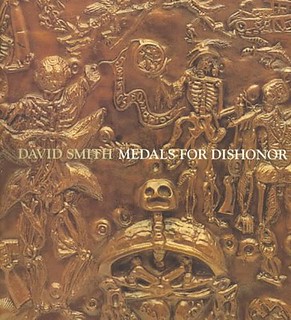 This catalogue examines a major though little-known body of David Smith's work. Enraged by the rise of fascism that he witnessed while visiting Europe in the 1930s, Smith began to work on the
This catalogue examines a major though little-known body of David Smith's work. Enraged by the rise of fascism that he witnessed while visiting Europe in the 1930s, Smith began to work on the Medals for Dishonor.
Approaching the tradition of commemorative medallions ironically, Smith denounces historical players who willingly contributed to the horrors of war.
Publisher: Independent Curators International (ICI)
Publication Date: 1997
Binding: Paperback
Language: English
Number of Pages: 84
Item Length: 9.5in
Item Width: 9.5in
For more information, or to order, see:
David Smith: Medals For Dishonor
(https://www.abebooks.com/servlet/BookDetailsPL?bi=31550781445)
David Smith : Medals for Dishonor by David Smith (1997, Trade Paperback)
(https://www.ebay.com/p/606777?iid=225731595160)
THE BOOK BAZARRE
NEW BOOK: ART & MONEY
Money artist Tom Badley has written a book on art and money. The Foreword is written by Elias Ahonen, author of the Encyclopedia of Physical Bitcoins and Crypto-Currencies and Blockland. -Editor
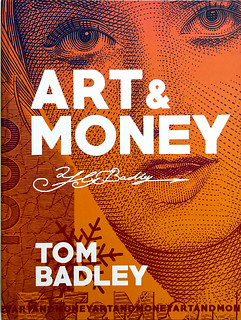 Banknotes: unique in the world of product design, a source of artistic inspiration, and the visual brand of money and debt. But why do we use cash? Why does it look the way it does? What does it say about us, life on Earth, and where we're going as a species?
Banknotes: unique in the world of product design, a source of artistic inspiration, and the visual brand of money and debt. But why do we use cash? Why does it look the way it does? What does it say about us, life on Earth, and where we're going as a species?
Artist Tom Badley brings together his experience in art, design, cryptocurrency, history, and his work in the banknote industry to present a unique philosophy of money design.
In doing so, he uncovers society's beliefs on life, evolution, and the future of money.
Daniel Ambrosi, founding member of the AI Art movement:
"Wow! This book went to places and depths I did not expect. Tom's thesis of money as a mirror of humanity and our evolutionary drive beyond centralization to self-determination is quite compelling. I found the chapters, The Hierarchy of Sophistication and Banknotes vs Art very illuminating and while reading those, I couldn't help but think about what I'm trying to do with my own art. I learned a lot from these chapters and came away encouraged by the aspiration towards transcendent life-affirming art. It was also great to get a much better handle on Tom's art, background, ideas, and philosophy. His work is truly singular and a tremendously important contribution to crypto art."
Tom Badley
Tom Badley is an artist, designer and author. He studied art at the Slade School of Fine Art, London, and the Cooper Union School in New York. He is known for his work in the banknote industry and blockchain art space. He lives and works in London and Europe.
Publisher : Independently published (July 10, 2023)
Language : English
Hardcover : 208 pages
ISBN-13 : 979-8397495349
Item Weight : 1.32 pounds
Dimensions : 8.25 x 0.68 x 11 inches
See the article elsewhere in this issue about Tom Badley's physical cryptocurrency notes. -Editor
For more information, or to order, see:
Art & Money
(https://www.bitcoin-banknote.com/)
ART & MONEY
(https://www.amazon.com/ART-MONEY-Tom-Badley/dp/B0CC4JBF4M/ref=sr_1_1)
To read earlier E-Sylum articles, see:
TOM BADLEY'S PORTFOLIO OF MONEY
(https://www.coinbooks.org/v22/esylum_v22n32a34.html)
NEW BOOK: GUIDE TO BECOMING A COIN DEALER
With help from a robot friend, Ron Guth has written A Practical Guide To Becoming A Coin Dealer. Here's the Foreword. There's no cover illustration yet, so I'd like to invite our readers to submit candidates, with or without the help of AI tools. -Editor
 ChatGPT, one of the most famous AI tools on the market at present, created this entire book in less than an hour. ChatGPT (Version 3.5) took the prompt,
ChatGPT, one of the most famous AI tools on the market at present, created this entire book in less than an hour. ChatGPT (Version 3.5) took the prompt, Outline for a book titled How to Become a Coin Dealer
, and created a ten chapter outline in just a few seconds. Each line in the outline became its own prompt from which ChatGPT generated entire sections in less than a minute each. The final count came to over 37,000 words. Compare this to the months it would have taken a human to write a similar book.
ChatGPT even provided alternative titles for this book, several of which were entirely appropriate, and from which the actual title was chosen.
How did ChatGPT perform? Surprisingly well in this writer's opinion. Though it took ChatGPT less than an hour to create the book, your editor spent several hours reviewing the text and adding notes. ChatGPT often repeats itself or rephrases sections, though that in itself is not bad. Good ideas should be reinforced. On the positive side, ChatGPT included several interesting topics that this writer had not even contemplated. ChatGPT has been known to hallucinate (make things up) and outright lie (make false statements), not out of evil intent but merely because of the nature and current state of the technology. In order to present the raw power and the idiosyncrasies of ChatGPT, no changes were made to the actual text or content. However, editor's notes were inserted within brackets [ ] throughout the text to correct or explain any errors or misinformation.
The end result is a book that, with the accompanying revisions, will prove to be very useful to anyone considering becoming a coin dealer. If nothing else, it illustrates the sheer power and potential of ChatGPT.
Important note: ChatGPT and the editor do not offer legal and tax advice. What may appear to be legal or tax advice in this book are guidelines only. Readers are encouraged to consult appropriate professionals for legal and tax advice.
Enjoy!
The book was published a chapter at a time on Ron's Numismatic Detective Agency blog. See the links below. -Editor
To read the complete book, see:
A Practical Guide To Becoming A Coin Dealer
(https://numismaticdetectives.com/blog/f/the-business-of-coins)
A Practical Guide...Chapter 1
(https://numismaticdetectives.com/blog/f/a-practical-guide-to-becoming-a-coin-dealer)
A Practical Guide...Chapter 2
(https://numismaticdetectives.com/blog/f/a-practical-guidechapter-2)
A Practical Guide...Chapter 3
(https://numismaticdetectives.com/blog/f/a-practical-guidechapter-3)
A Practical Guide...Chapter 4
(https://numismaticdetectives.com/blog/f/a-practical-guidechapter-4)
A Practical Guide...Chapter 5
(https://numismaticdetectives.com/blog/f/a-practical-guidechapter-5)
A Practical Guide...Chapter 6
(https://numismaticdetectives.com/blog/f/a-practical-guidechapter-6)
A Practical Guide...Chapter 7
(https://numismaticdetectives.com/blog/f/a-practical-guidechapter-7)
A Practical Guide...Chapter 8
(https://numismaticdetectives.com/blog/f/a-practical-guidechapter-8)
A Practical Guide...Chapter 9
(https://numismaticdetectives.com/blog/f/a-practical-guidechapter-9)
A Practical Guide...Chapter 10
(https://numismaticdetectives.com/blog/f/a-practical-guidechapter-10)
A Practical Guide...Conclusion
(https://numismaticdetectives.com/blog/f/a-practical-guideconclusion)
EMIL NICHOLAS EUSANIO (~1925-2022)
Adrián González-Salinas of Monterrey, Mexico shares this information about an NBS member and numismatic literature dealer who passed away in February 2022. Thanks! -Editor
 Last month, I bought on eBay a lot of twenty COINage magazines (1972-1984) and in the February 1978 issue, page 17 there is a very interesting article written by Bob Wolenik and titled "He Deals In Coin Books". At that time Emil Nicholas Eusanio was working as an engineer at Rockwell, International and he was the owner of "San Fernando Book Co." in California.
Last month, I bought on eBay a lot of twenty COINage magazines (1972-1984) and in the February 1978 issue, page 17 there is a very interesting article written by Bob Wolenik and titled "He Deals In Coin Books". At that time Emil Nicholas Eusanio was working as an engineer at Rockwell, International and he was the owner of "San Fernando Book Co." in California.
Emil said: "I found the books were harder to find than the coins, so I never got around to purchasing the coins".
I was looking for information about Emil N. Eusanio and found that he was the son of Emil Eusanio (1902-1975) and Lucy Marrano (1908-2007) and both native from Italy (most likely from the Abruzzo region). His parents came from Italy to New York in 1905.
Emil N. Eusanio was a mechanical engineer graduated from the University of Buffalo (NY) generation 1946-1950. On October 13, 1973 he married Patricia L. Kinman in Los Angeles, California.
Numismatically, Emil was an associate member of the American Numismatic Society since 1967. In "The Asylum" Summer 1985 (page 13) he is listed as a new member of the NBS.
He was a member of the California State Numismatic Association (#3066) in 1976; The Society of Paper Money Collectors (#5092) in 1977 and the Numismatic Association of Southern California (#2223) in 1980.
With respect to The E-Sylum, he appeared as a new member in Vol. 5 # 36 (02 September 2002); Vol. 8 #44 (16 October 2005) and Vol. 18 #16 (19 April 2015).
Finally, I found an obituary of his passing in February 2022.
Back in my early collecting career I was aware of the San Fernando Book Co., but don't recall if I purchased any coin books there. Emil subscribed to The E-Sylum three times, perhaps due to email address changes. I don't see any submissions from him in the archive, and never met him in person that I'm aware of. Can any of our readers tell us more about him? -Editor
To read the earlier E-Sylum articles, see:
SUBSCRIBER UPDATES
(https://www.coinbooks.org/club_nbs_esylum_v05n36.html)
WAYNE'S WORDS
(https://www.coinbooks.org/club_nbs_esylum_v08n44.html)
WAYNE'S WORDS: THE E-SYLUM APRIL 19, 2015
(https://www.coinbooks.org/esylum_v18n16a01.html)
BOB LYALL (1938-2023)
Ken Eckardt writes:
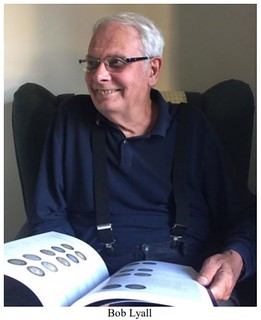 "Bob Lyall passed away on 11th December 2023 at the age of 85. The relatively small community of collectors of West Indian cut and countermarked coins have lost a true cornerstone in our series.
"Bob Lyall passed away on 11th December 2023 at the age of 85. The relatively small community of collectors of West Indian cut and countermarked coins have lost a true cornerstone in our series.
"Bob was a collector from a young age and in his teens focused on the coinage of Charles I. This eventually developed into a serious collection. In 1958 Bob did his National Service in the Royal Navy and this included a period of time in the West Indies and British Honduras. Something about the region stuck in his mind and in 1969/1970 Bob started collecting the cut and countermarked coins from the Caribbean islands. Over the years many letters were written to collectors, libraries and archives seeking information and as a result a number of articles were written.
"I met Bob through correspondence in 1975 and when I first visited the UK, in 1977, Bob organised a weekend visit to Fred Pridmore's home. What a valuable experience that was for both of us. Bob's most important work was published by Spink & Son in 1998, ‘West Indian Coinage – Some New Discoveries.' This work brought to light a number of previously unpublished Acts, Decrees and Proclamations that greatly added to our knowledge of this fascinating series.
"Bob also was a keen collector of tokens from the West Indies and British Colonies and he formed a very comprehensive collection. In 1988 the Token and Medal Society published his book ‘The Tokens, Checks, Metallic Tickets, Passes and Tallies of the British Caribbean and Bermuda'. He later privately published ‘The Tokens and Checks of Malta' and ‘The Tokens and Checks of Gibraltar'.
"The sale of Bob's collection of cut and countermarked coins through DNW, in September 2018, established a new milestone in the series with the number of rarities offered.
"A great friend and colleague of mine going back nearly 50 years … I will miss him."
Sorry to hear the news. Bob was a reader and contributor to The E-Sylum over many years - see some of his submissions linked below.
Here is an excerpt from Ken's preface for Bob's collection in the Dix Noonan Webb catalog. -Editor
 Bob Lyall has been a cornerstone with respect to research on the West Indies cut and
countermarked series for many years. A major achievement was the publication of a very
important booklet, West Indian Coinage — Some New Discoveries , by Spink in 1998. This
work brought to light a significant amount of contemporary documentation not previously
published in the numismatic domain. Additionally, his work covers much more as evidenced by
his book on West Indies tokens, and publications on Gibraltar, identifying this colony as the
original location for the series of heart-shaped piercings (the earliest examples of mutilated
coinage for British colonial use) in 2008, his book on the tokens of Malta, along with a number of articles published in Spink's Numismatic Circular over the years.
Bob Lyall has been a cornerstone with respect to research on the West Indies cut and
countermarked series for many years. A major achievement was the publication of a very
important booklet, West Indian Coinage — Some New Discoveries , by Spink in 1998. This
work brought to light a significant amount of contemporary documentation not previously
published in the numismatic domain. Additionally, his work covers much more as evidenced by
his book on West Indies tokens, and publications on Gibraltar, identifying this colony as the
original location for the series of heart-shaped piercings (the earliest examples of mutilated
coinage for British colonial use) in 2008, his book on the tokens of Malta, along with a number of articles published in Spink's Numismatic Circular over the years.
Bob developed a collecting interest at quite an early age, starting off with artefacts and objects of interest given to him by family members. By the age of twelve his interest focused primarily on numismatics. He was already on his way to forming a significant collection of the coinage of Charles I (sold in these rooms in 2015 and 2016) when he had his first exposure to the West Indies (including Bermuda, Bahamas and British Honduras) in 1958, performing his National Service with the Royal Navy.
While some issues are common (common being a relative term in this series), many are great rarities. Accordingly, the collecting fraternity has been small in number, due not only to the lack of material but also to the limited understanding of the social and economic conditions that brought about the existence of these coins. It is gratifying to see that in the past 8-10 years there has been a marked increase in interest by collectors and students, and a genuine recognition of the rarity of the coins in general. It is not the easiest series to understand, complicated as it is by ‘unofficial' specimens, ‘contemporary counterfeits' and, sadly, ‘modern fakes'. With study the first two categories add significant interest to the series and indeed these coins formed an integral part of the day-to-day marketplace transactions for which the various island assemblies took steps to enact this exceptional local coinage. With very few exceptions, study and close examination can usually detect and identify the third category.
Bob, being a faithful student of the series, focused on study and research, writing literally hundreds of letters to museums, historical societies and individuals who might have useful information, and visiting various libraries and museums in the UK and the West Indies.
To read the complete catalog on the Newman Numismatic Portal, see:
The Lyall Collection of Cut and Countermarked Coins
(https://nnp.wustl.edu/library/auctionlots?AucCoId=512703&AuctionId=539434)
To read earlier E-Sylum articles, see:
ON NAMING NAMES
(https://coinbooks.org/esylum_v09n06a07.html)
ON ELECTROTYPES
(https://www.coinbooks.org/esylum_v09n43a14.html)
FIRST LOOK: THE MINING AND RELATED TOKENS OF WEST CUMBERLAND, UK
(https://coinbooks.org/esylum_v09n53a08.html)
LYALL COLLECTION OF CUT AND COUNTERMARKED COINS
(https://www.coinbooks.org/v21/esylum_v21n28a24.html)
CHRISTMAS RIDDLES & THE COIN COLLECTOR
Newman Numismatic Portal Project Coordinator Len Augsburger provided the following holiday report. -Editor
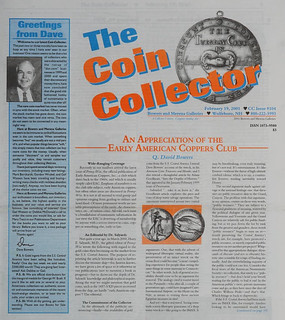 Christmas Riddles & The Coin Collector
Christmas Riddles & The Coin Collector
The Coin Collector, a monthly house organ published in tabloid form by Bowers & Merena from 1994 to 2003, numbered 144 issues total. The readable Bowers formula combined coin commentary, the occasional presentation of original research, letters to the editor, engaging graphics, and of course coins for sale. The Internet has rendered the format obsolete, a pity for those of us who eagerly snatched such publications from the mailbox. From the February 19, 2001 issue (no. 104) come a pair of Christmas riddles contributed by reader Dr. Kathy Helgesen Fuller, a long time reader of our publications.
Q. What do you call Santa's helpers?
A. Subordinate Clauses.
Q. What do you get when you cross a snowman with a vampire?
A. Frostbite.
Q. What do you call an elf who sings?
A. A wrapper.
OK, we confess the third riddle is a Chat GPT special. The reader is left to determine if AI is an improvement or not!
Link to The Coin Collector on Newman Portal:
https://nnp.wustl.edu/library/publisherdetail/539529
VIDEO: FEBRUARY 2017 LONG BEACH EXPO
The David Lisot Video Library on the Newman Numismatic Portal can be found at:
https://nnp.wustl.edu/library/multimediadetail/522852
We highlight one of his videos each week in The E-Sylum. Here's one from 2017 from the Long Beach Expo. -Editor
The Long Beach is held three times a year and always have great exhibits and numismatic events. The Expo displayed the first United States Silver Dollar with Don Willis and JD Dannreuther, talked to Tom Caldwell who purchased a 1943 Copper Cent, and saw John Highfill announce his plans to run for ANA Board of Governors. Speaker(s): Interviewer: David Lisot.
To watch the complete video, see:
https://nnp.wustl.edu/library/book/578920
CHARLOTTE MINT MUSEUM COIN EXHIBIT
Greg Adams writes:
"In last week's article author Pete Smith wrote that the Mint Museum, Charlotte, North Carolina "is an art museum without numismatic exhibits." I'm happy to report that Mr. Smith is misinformed. While the museum is indeed an Art museum, it does have a small numismatic display. I visited briefly in mid October and took the attached photos.
"The display is very limited. About 4-5 panels in a side hallway off the main lobby. The display includes some brief background and a display of a couple of dozen C mint mark coins (Dollars, 1/4 Eagles and 1/2 Eagles!) Dated 1838-1861."
Thanks - that's good to hear. Here are the rest of Greg's photos. -Editor
To read the earlier E-Sylum articles, see:
MONEY MUSEUMS IN THE U.S., PART ONE
(https://www.coinbooks.org/v26/esylum_v26n49a16.html)
MONEY MUSEUMS IN THE U.S., PART TWO
(https://www.coinbooks.org/v26/esylum_v26n49a17.html)
NOTES FROM E-SYLUM READERS: DECEMBER 17, 2023
A $3 Gold Piece Love Token
Ken Barr writes:
"Well, if we're showing off holiday love tokens, I can contribute my only love token on a $3 gold piece, and it's a nice one!
"FYI, the entire gallery of My Favorite Love tokens is available at: http://www.kenbarr.com/lovetokens.html"
Nice - thank you. Check out Ken's Love Token gallery. -Editor
To read the earlier E-Sylum article, see:
NOTES FROM E-SYLUM READERS: DECEMBER 10, 2023
Christmas 1884 Love Token on $1 Gold Piece
(https://www.coinbooks.org/v26/esylum_v26n50a10.html)
More on Mint Document Destruction
Researchers Richard Kelly and Nancy Oliver write:
"We read Roger Burdette's article on document destruction in the December 10th E-Sylum, and thought we would like to add to his eye-opening announcement. We had an August 2014 Numismatic Chronicles column in The Numismatist, entitled "Gone Forever", that discussed mint archive destruction as well from 1926. Attached is a portion of that column."
Thank you! So sad. -Editor
We begin with the uncovering of a letter dated August 16, 1926, in the records of the National Archives in San Bruno, CA. In it, San Francisco Mint Superintendent Michael J. Kelly responded to a query from Mint Director Robert J. Grant about document-destruction mandates for all the mints. (The directive came from a report – H.R. No. 1402, 69th Congress – dated June 8, 1926) In the letter, Kelly wrote, ‘In regard to the destruction of useless papers, documents, and records located in this institution, the material was prepared for sale.' He then listed several companies that were asked to submit bids to destroy the documents, and only one did – the Independent Paper Stock Company, at 5 cents per 100 pounds.
From Kelly's Disposition of Useless Papers
letter, we found 87 items listed for the San Francisco Mint alone, of which we believe 11 were to be the greatest loss:
1. Coiner's delivery books, 1875-1900
2. Gold clipping, leather bound book, 1870-1911
3. Payroll, melting and refining department, leather bound book, 1892
4. Register of ordinary expenses, 1886-1904
5. Coiner's record of gold coinage submitted to the mint superintendent, 1889-1896
6. Visitor's register, 18979-1914
7. Coiner's record of gold coinage, 1882-1889
8. Records of gold coinage, 1879-1909
9. Gold coinage register, 1879-1898
10. Coinage department leather bound books, 1870-1878
11. Forty wooden chests of miscellaneous papers, 1856-1920 (Superintendent Kelly placed an asterisk beside the listing of the 40 wooden chests, saying they consist of papers that originated in the bookkeeper's office and the figures carried into permanent record books.
)
However the San Francisco Mint was not the only mint that was listed for document destruction, for the report included 33 items from the Philadelphia Mint, and 4 more from the Carson City Mint. We have partial lists from both if anyone is interested.
To read the earlier E-Sylum article, see:
1894 LETTER ON MINT DOCUMENT DESTRUCTION
(https://www.coinbooks.org/v26/esylum_v26n50a11.html)
John Kallman
Jim Contursi writes:
"With much regret, I have the sad duty to announce the passing of long-time numismatist, John Kallman, on December 7. Among his many numismatic accomplishments, he authored Military Tokens and Chits of China, Korea, and Taiwan, published Cash Coin Connection newsletter, and was a major contributor to the online sites of the Casino Chip & Gaming Tokens Club and the Museum of Gaming History. Doubtless, he was known to many of your readers."
So sorry to hear the news. Thank you. -Editor
THE PROOF COIN IS IN THE PUDDING!
David Pickup kindly submitted this seasonal offering. Thank you! -Editor
Fresh white coins
The Birmingham Daily Post on 26th December 1889 commented that there is always a great demand for new coins from Royal Mint at Christmas for gifts to postmen, messengers, family. Most people want a fresh white shilling, florin or crown.
Even the thrifty threepence
were in demand for puddings. It is interesting that new coins are described as white
.
Sickly coins
On 25th December 1925 the Western Gazette reported that the Royal Mint normally issued more coins at Christmas. In previous years silver threepences were popular but that had declined because they turn a bilious
(sickly) colour when cooked! Before 1920 coins contained 92.5% silver. Perhaps the colour change related to the reduced bullion content.
A Christmas Wreath will cheer you up.
In 1928, the Wreath Type silver crown designed by Kruger Gray was very popular and the issue was continued for several years at the request of the Bank of England who liked to stock them at Christmas time to give them to good clients. The mintages of crown were always quite low for the normal currency pieces and are now scarce and valuable.
Silver coins in Christmas puddings
The Dundee Evening telegraph on 15th December 1937 reported on revival of the custom of coins in puddings led to an increased demand for new silver threepences of George VI. The neat
silver threepence had taken a fancy to the public, but many of the new twelve sided coins were being hoarded by collectors. The paper said it would of course
be dangerous to put the twelve sided ones in puddings.
Dark pennies
There were dark times (no pun intended!) ahead for the penny in the 1930s. After the enormous demand of the First World War period no pennies were required from 1923 to 1925 and again in 1933 none were needed for circulation. The Royal Mint dulled the colour of the penny in 1934. The Deputy Master of the Royal Mint wrote the following in his Annual Report of 1934 about the darkening of pennies:
"… the constant demand for bright new pennies, so much desired for the Christmas stocking, a demand which is spurious to the extent that it is followed, as it often is, by inconvenience to the Banks when the young recipients disgorge their treasures in exchange for other delights which subsequently appeal still more to their taste. Last Christmas, therefore, I felt compelled to meet these views of the Bankers and arranged that all new pence, for the time being, should be issued only after their attractive sheen had first been removed. I am glad to be able to report that, in view of the clear evidence we now have of a very large increase in the genuine demand for pennies this year, the precaution has not proved necessary."
This seems an odd statement to make. It sounds as though they had made a mistake in stopping production in 1933 of pennies and were blaming parents for giving new pennies to children who then spent them on other delights
. I wonder if dulling the lustre made much difference to children determined to buy a bar of chocolate.
Hidden danger in Christmas puddings!
In 2005, British supermarket chain, Sainsbury, decided to add sixpence coins to their puddings. They spent months trying to obtain enough coins, only to give up on the idea as the "lucky sixpences" "constitute a choking hazard". "We can't supply the coin already mixed into the pudding," a spokesman said. "Instead we have provided a collector's card with the coin attached that you can place under a plate or table mat for one lucky friend or family member to find." Many shop-bought Christmas puddings were then heated in a microwave oven, leaving metal coins in the mix could be dangerous, the store added.
AN IRISH NUMISMATIC TWELVE DAYS OF CHRISTMAS
Ronan Fitzpatrick writes:
"Retired Chairman at the Numismatic Society of Ireland Michael E. Kenny recently showed me the E-Sylum article titled The Twelve Collecting Days of Christmas by David Pickup and Adam Spikes which he had enjoyed reading. He suggested two alternatives from the series of Irish coins that would be suitable choices and asked if I might have some more. Derek Kerins suggested some Irish contributions too. And so, the idea of An Irish Numismatic Twelve Days of Christmas was born. A little authors' licence and a sprinkling of Irish Christmas magic have been added to our composition where transferable examples are not available. To keep things simple, just the twelfth day is celebrated here. Enjoy."
Thank you! Happy holidays, everyone! -Editor
To read the earlier E-Sylum articles, see:
THE TWELVE COIN COLLECTING DAYS OF CHRISTMAS
(https://www.coinbooks.org/v21/esylum_v21n51a25.html)
THE TWELVE COLLECTING DAYS OF CHRISTMAS
(https://www.coinbooks.org/v25/esylum_v25n52a27.html)
VOCABULARY TERMS: OVERLETTER, OVERLETTERING
Here's another entry from Dick Johnson's Encyclopedia of Coin and Medal Terminology. I added an image from the Stack's Bowers August 2018 ANA sale. -Editor
Overletter, Overlettering. One or more letters on a die reworked by punches or re-engraved to correct the lettering. Like overdating, new letters are intended to replace existing letters, to update or correct a die so it may continue to be used. The die is softened and new letters are overpunched the existing letters in a die (which is then hardened by heat treating and placed in use). Or, the die can be softened and reworked by hand engraving, cutting new letters deeper into the die to obliterate the incorrect existing letters. Often parts of the under letter can be seen near the replaced letter on pieces struck from a reworked die.
An example exists at the Philadelphia Mint in 1836. The mint had acquired its first steam-powered press, the Thonnelier, (in Franklin Peale's efforts to bring American coin technology up to European standards). Appropriately, mint officials wanted to celebrate this coining milestone by issuing a medal.
 The date was set for Washington's birthday, February 22, 1836. Dies were cut and medals struck in preparation of the coming celebration. But mechanical troubles precluded meeting the scheduled date. Instead it was postponed for a month, to March 23.
The date was set for Washington's birthday, February 22, 1836. Dies were cut and medals struck in preparation of the coming celebration. But mechanical troubles precluded meeting the scheduled date. Instead it was postponed for a month, to March 23.
Mint engraver Christian Gobrecht, who had cut the dies, reworked the reverse die by punching in MAR over the letters FEB. He also changed the 22 date to 23. New medals were struck, this time on the very day. Even today these medals exhibit the overlettering on the reverse of the March variety of medals (Julian number MT-21). Also see die retooling; die variety; punch, puncheon (1); repunch, repunching; update, updating.
References:
O37 {1977} Julian MT-20, MT-21, p 192-193.
To read the complete lot description, see:
1836 First Steam Coinage Medal. Bronze. 27 mm. By Christian Gobrecht. Julian MT-21. MS-65 BN (NGC).
(https://auctions.stacksbowers.com/lots/view/3-BJDPX/1836-first-steam-coinage-medal-bronze-27-mm-by-christian-gobrecht-julian-mt-21-ms-65-bn-ngc)
To read the complete entry on the Newman Numismatic Portal, see:
Overletter, Overlettering
(https://nnp.wustl.edu/library/dictionarydetail/516443)
THE BOSTON STAMP HEISTS
E-Sylum Feature Writer and American Numismatic Biographies author Pete Smith submitted this article on the Boston Stamp Heists, indirectly linking mobster James "Whitey" Bulger to a numismatic crime. Thanks! -Editor
There was a series of thefts of stamp collections in the Boston area during 1971 to 1973. The total estimate of losses exceeded a third of a million dollars. The individuals involved included a number of prominent stamp and coin dealers, thieving police officers, corrupt FBI agents, criminal gangs and organized crime figures.
Two masked gunmen robbed the store of Confederate Philately in Back Bay Boston on March 17, 1971.They took stamps from a safe that was open for inventory and filled two green bags. The owner, Jack E. Molesworth, was vacationing in Florida at the time. Taken were 400,000 stamps. Joseph McDonald and James Sims were suspected of involvement in the crime. They were both convicted and sentenced for other crimes.
On Saturday, January 29, 1972, there was a burglary at the home of Don Romano in Hingham, Massachusetts. Taken was a coin collection and rare stamps from the collection of D. Corrado Romano valued at $68,000. He was the owner of the Worthy Coin Co, in Boston.
Three suspects in the Romano case were quickly arrested for possession of stolen property including coin dealer Michael R. Kirzner and his wife Julia of Cohasset. Also arrested was James B. Tilley of North Abington. Most of the stamps were recovered.
There was a burglary of the Cardinal Spellman Philatelic Museum on the campus of Regis College in Weston, Massachusetts, on March 31, 1973. The thieves cut the alarm system, entered through a back door and broke into a walk-in safe. Initial estimates of the loss were $50,000 to $100,000.
In October of 1974, the FBI announced indictments and arrests against eleven men involved with the series of thefts.
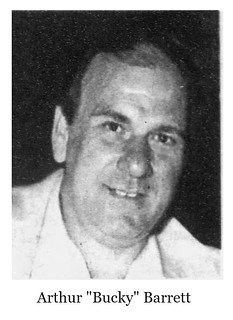 Arthur M.
Arthur M. Bucky
Barrett (36 in 1974) of Dorchester had a criminal record. He was charged
with assault and battery in 1957. In 1969 he was arrested on the roof of a hardware store with
burglary tools in his possession.
His big score came in 1980 with $1.5 million taken from the Depositors Trust in Medford. He
joined three police officers and two other burglars to break into 755 safe deposit boxes over the
Memorial Day weekend. They paid a $100,000 tribute to James Whitey
Bulger who then
informed on them to the FBI. The others were brought to trial in 1986 but by then Barrett was
not available.
In 1983 he faced charges for transporting large quantities of marijuana through Boston. In July of 1983, Whitey Bulger lured Barrett to a house in Boston. There he was held at gunpoint, chained to a chair and interrogated for hours until he gave up locations of his money. He was shot in the back of the head and buried in the cellar. Later his body was moved to another location and not discovered until 2000.
Barrett's widow Elaine filed a wrongful death suit against the United States and the FBI. She claimed that the FBI protected Bulger from prosecution as a confidential informant and allowed him to commit additional crimes without fear of prosecution. While all that was true, her claim was denied as untimely.
Michael Richard Kirzner (29 in 1974) was the owner of Michael R. Kirzner Rare Coins and Cosmic Coin Co. in Boston. He was the primary fence who arranged the sale of stolen stamps to other willing dealers. He pleaded guilty to one count and testified for the prosecution at trial. As LM-816, he was suspended from the ANA in 1972 and expelled in 1976. On December 10, 1976, he was riding in a car and shot in the back from another car. He was treated at a hospital and released.
At trial, Michael Kirzner testified that Ben Tilley asked him to appraise stamps stolen from the Spellman Museum. Also present during the appraisal was Bucky Barrett. Kirzner called Donald Townsend who declined to buy the stamps but passed the offer on to Michael Bass. Bass came to Boston, viewed the stamps, met with Kirzner, Tilley and Barrett and agreed to buy a portion of United States stamps for $10,000. Payment was made to Tilley who gave Kirzner $1000 as a commission.
Michael Bass testified at trial that Barrett claimed that he climbed a telephone pole to disarm the alarm system. Bass gave Townsend and Griffiths $500 as a finders' fee. Bass agreed to testify in return for lenient treatment. Authorities showed Bass photographs of 20 to 25 men with criminal records and asked him to identify any who were in the meetings. Those men were arrested but charges were dropped in some cases when there was no corroborating evidence.
There was much publicity when others were arrested but few stories of convictions or sentences.
Buzzy
Adams was a convicted burglar and thief. He testified for the prosecution and was not
charged. There may have been some confusion between the names of Bucky and Buzzy.
Laurence M. Brasler (24 in 1974) of the Laurence Martin Brasler Co, of North Hollywood, CA, was charged in 1974 with transportation of stolen property.
Frederick M. Chiampa (54 in 1974) of Boston had a criminal record and was arrested based on identification of a photograph by Bass. Charges were dropped.
William Joseph Creehan, Jr. (46 in 1974) of Hyde Park was identified by Bass through a photo but charges were dropped.
Sam Frudakis (1918-2009) of Trader Sam's Coins and Stamps was one of the promoters of the Long Beach Stamp and Coin Exposition. It was charged that he conspired with Michael Kirzner to distribute stolen stamps. He pleaded guilty in October 1975 to transporting stolen stamps across state lines and was sentenced to ten days in jail.
David Rynd Griffiths (1942-2010) of the California Coin and Stamp Galleries Inc. in Los Angeles was charged as a codefendant. Those charges were dismissed.
Peter George Kenedi (1927-1987) was affiliated with Peter Kenedi of California Co. Inc. and Eastland Stamp Galleries in Michigan. He had a prominent stamp auction company. He was charged in 1974 with transportation of stolen property.
Alex Korn (1940-1994) of Advanced Philatelics of Los Angeles, was charged in 1974 with interstate transportation of stolen property.
Ray Lundgren (56 in 1975) was owner of Century Stamp and Coin Co, of Los Angeles. He was charged with conspiracy with Michael Kirzner to distribute stolen stamps. He agreed to testify in court but was shot and killed in 1976.
Edward J. McAleney (1912-1988) of Halifax had a criminal record going back to 1930 and was involved in a 1968 Boston Brinks robbery. He pleaded guilty to one count.
Joseph Maurice McDonald (1917-1997) was suspected in the Molesworth robbery. He
disappeared in October 1975 and was placed on the FBI Ten Most Wanted
list. He was also
wanted for questioning in the murder of Ray Lundgren. He was taken into custody on September
15, 1982. He received a six year sentence on an unrelated race-fixing scheme.
Edward S. Powell (50 in 1975) of Altadena, California, was arrested on March 18, 1975, and 340,000 stamps stolen from Jack Molesworth were recovered. He was holding them until they cooled off.
James Sims (40 in 1975) was charged with transporting stolen property across state lines and selling stolen stamps to Sam Frudakis. Like McDonald, he was a fugitive and convicted in an unrelated race-fixing scheme.
Benjamin Franklin Tilley Sr. (1909-1974) had been frequently arrested and occasionally convicted of past burglaries. He avoided prosecution in the Spellman case by dying in an auto accident on April 16, 1974.
James Bradford Tilley (1911-1989) was the brother of Ben with a long criminal record. At the time of the 1940 Census, he was in jail and in 1950 he was in prison. He was arrested based on identification by Bass from a photograph. He was probably not involved.
Donald Townsend (32 in 1974) of the California Coin and Stamp Galleries Inc, of Los Angeles was charged as a codefendant. Those charges were dismissed. He testified for the prosecution.
From all this, it appears that Arthur Barrett, Edward McAleny and Ben Tilley were organized gang members who conducted the Cardinal Spellman Philatelic Museum heist. Coin Dealer Michael Kirzner arranged the sale to Michael Bass who avoided prosecution. Prosecution of the various other coin and stamp dealers was minimal.
Several of the people involved had criminal careers much more extensive than the brief descriptions included here.
To read an earlier E-Sylum article, see:
DON CORRADO ROMANO (1903-1984)
(https://www.coinbooks.org/v21/esylum_v21n40a12.html)
NATIONAL SILVER DOLLAR ROUND TABLE ESSAY
Mike Faraone of the National Silver Dollar Round Table passed along word of the group's 2024 YN essay competition. Good Luck! -Editor
As an NSDR board member I have the pleasure of announcing a Young Numismatist (YN) essay competition for early 2024. Essays must be written solely by the YN who has not reached his 19th birthday by March 1, 2024 and can cover any aspect of United States silver dollars. Essay length should be from 300 to 500 words and must be received by the NSDR by March 1, 2024.
Winners of the competition will be announced March 17, 2024. The first place winner will be awarded a scholarship for one week attendance at the ANA Summer Seminar to include airfare. Second and third place will receive a US Savings Bond for $500 and $250 respectively.
A typed double-spaced essay should be sent to:
Mike Faraone/NSDR
PO Box 752132
Las Vegas, NV 89136
For more information on the National Silver Dollar Round Table, see:
https://www.nsdr.net/
ATLAS NUMISMATICS SELECTIONS: DECEMBER 17, 2023
Atlas Numismatics has updated their website with 330 new coins, medals, and tokens at fixed prices. Selections include the following items. -Editor
1076737 | ROMAN REPUBLICAN. ETRURIA. Populonia. Struck circa 300-250 BC. AV 25 Asses. NGC Ch. AU (Choice About Uncirculated) Strike 5/5 Surface 4/5. 11.5mm-13mm. 1.39gm. ??V (retrograde). Lion's head with tongue protruding, right / (Blank). Vecchi 21.70, obverse die O1, this piece; Vecchi, SNR 67 (1988) 47.28, this piece; SNG ANS 2, same die; SNG Lloyd 10 = Jenkins AGC 475, same die).
Ex P.& P. Santamaria listino (1961) No. 2; Ex Münzen und Medaillen Auction 44, Basel
(15 June 1971) Lot 1; Ex Peus Auction 336, Frankfurt (199) Lot 5; Ex Tradart (18
November 1993) Lot 5 (Color plate pg. 28); Ex European Connoisseur collection
(formed before 2002).
$19,500
To read the complete item description, see:
https://atlasnumismatics.com/1076737/
1076871 | FRANCE. Napoleon III. (Second Empire, 1852-1870). 1852-A AR 5 Francs.
PCGS MS65.
By Jean-Jacques Barre. Paris. Edge: DIEU PROTEGE LA FRANCE ***.
(lamp) LOUIS-NAPOLEON BONAPARTE (hand). Head, left; signed below truncation /
REPUBLIQUE FRANÇAISE. . Denomination within wreath. KM 773.1; Gadoury 726
(Tête étroite); F.-329.
$2,695
To read the complete item description, see:
https://atlasnumismatics.com/1076871/
1076314 | GERMAN STATES. Schaumburg-Lippe. Albert Wolfgang. (1728-1748). 1732 AV Medallic 2 Ducats. NGC MS64. 25.5mm. 6.83gm. HVCVSQVE/ (Jehova). Radiant name of Jehovah in Hebrew letters over the view of the castle / LAPSA
ERIGAM/ (Jehova). Radiant name of Jehovah in Hebrew letters over a foundation stone
and seven ashlars. Weinmeister 32 (in Silver).
On the fire of Bückeburg castle, February 21st and the beginning of the restoration on
July 3rd.
$29,500
To read the complete item description, see:
https://atlasnumismatics.com/1076314/
1076771 | GREAT BRITAIN. England. William and Mary. (Monarchs, 1688-1694).
1692 AV Five Guineas. PCGS AU58.
Edge: • ¹ • DECVS • ET • TVTAMEN • ANNO •
REGNI • QVARTO • ¹ •. 41.63gm. GVLIELMVS • ET • MARIA • DEI • GRATIA.
Conjoined heads of William and Mary right / • 16 - 92 • MAG • BR • FR • ET • HIB • -
REX • ET • REGINA. Crowned quartered shield of arms. KM 479.1; SCBC-3422; Fr.-
299.
$78,500
To read the complete item description, see:
https://atlasnumismatics.com/1076771/
1076069 | NETHERLANDS. Holland. 1730 AR 6 Stuivers, Scheepjesschelling. NGC
MS66.
Edge: Plain. MO: NO: ORD: HOLL: ET WESTFRI:. Crowned arms of Holland
divides value, date above / VIGILATE DEO CONFIDENTES ·. Sailing ship. KM 45;
CNM 2.28.116; V. 55.6.
$1,950
To read the complete item description, see:
atlasnumismatics.com/1076069/
Upcoming Events
Atlas will be attending the following numismatic convention:
The 52nd New York International Numismatic Convention (NYINC) Empire Ballroom, Table #311
January 11-14th, 2024
Venue address: 111 East 48th Street and Lexington Avenue, New York, NY.
For more information:
http://www.nyinc.info/
Updates to their online inventory are issued monthly.
For more information and to sign up for the firm's monthly newsletter, visit: atlasnumismatics.com
NUMISMAGRAM MEDAL SELECTIONS: DECEMBER 17, 2023
Numismagram's Jeremy Bostwick forwarded these four medals from his most recent upload of new material to his site. For all of the new items, please visit https://www.numismagram.com/inventory. -Editor
102604 | GERMANY. Silesia. Noah's Ark silver Medal. Issued circa 1736. On the desire for an end to famine (21mm, 2.71 g, 12h). By J. L. Oexlein in Nürnberg. BEFIEHL DEM HERREN DEINE WEGE (surrender yourself to the Lord...), Noah's Ark facing right upon the water; above, dove flying left, with olive branch in beak; in two lines in exergue, UND HOFFE / AUF IHN (...and place your hope in Him...) // ER WIRDS WOHL MACHEN (...for He will do it), seven worshipers on their knees in act of prayer; lighted altar between them; rainbow arcing across the sky above; representation of an ark (alluding to Noah's Ark atop Mt. Ararat) upon hill in background to right. Edge: Plain. F&S 4240; Erlanger 2751. Mint State Details. Lightly toned and highly brilliant, with a few inconsequential marks on the rims accounting for the details designation. A charming and fairly small medal that packs a great deal into its size. $395.
The precise sentiments of this small medal are not entirely known, as some have ascribed it to the plight of Salzburg emigrants, while others suggest an end to famine being experienced locally in Silesia. Given the iconography, a famine seems more likely given the cataclysmic effect of the flooding relating to Noah's Ark, but the religious sentiment is strongly recounted no matter the event commemorated.
To read the complete item description, see:
102604 | GERMANY. Silesia. Noah's Ark silver Medal.
$395Price
(https://www.numismagram.com/product-page/102604)
102646 | UNITED STATES & GREAT BRITAIN. Crystal Palace white metal Medal "So-Called Dollar." Issued 1854. Commemorating its removal and re-opening in Sydenham (41mm, 12h). By Pinches in London. Britannia standing facing, head lowered left, holding key and caduceus, and opening the doors of Industry and Science; lamb to left, crested helmet to right; interior view of the palace in the background // CRYSTAL PALACE / OPENED MDCCCLIV, perspective view of the Crystal Palace. HK 8 (listed as Extremely Rare); BHM 2549; Eimer 1847. PCGS SP-61. Extremely lustrous and brilliant in the fields. Compare to an NGC MS-63 that realized a total of $840 in Heritage's February 2023 British Medals Showcase Auction #61308, lot 22073 (and for which its current owner wants at least $1,260 [!]). $565.
One of the earliest pieces listed in the popular reference on "so-called" dollars by Hibler & Kappen, this Crystal Palace type isn't actually American, but in fact, British. It commemorates the re-opening (in 1854) of the Crystal Palace in Sydenham in south London after it had been deconstructed and removed from Hyde Park in central London. In the United States, a version was constructed in New York City in the area that is now Bryant Park. It opened on 14 July 1853, and remained open intermittently until 5 October 1858 when it was destroyed by fire.
To read the complete item description, see:
102646 | UNITED STATES & GREAT BRITAIN. Crystal Palace white metal Medal.
(https://www.numismagram.com/product-page/102646)
102653 | FINLAND. International Women's Year multipiece bronze Medal. Issued 1975 (50mm, 206.57 g, 12h). By K. Räsänen for Sporrong. Top piece, obverse: Female head right, wearing earring and with hair strands billowing around her // Top piece, reverse: KAUKO RÄSÄNEN 1975, nude female in incuse, with hands raised, revealing heavily pregnant midsection. /// Middle piece, obverse: Fetus curled within womb // Middle piece, reverse: Exterior of the woman's midsection /// Bottom piece, obverse: Four nude females embracing, their bodies somewhat overlapping in design // Bottom piece, reverse: INTERNATIONAL WOMEN'S YEAR 1975, nude female in relief, with hands raised, revealing heavily pregnant midsection. Edge: SPORRONG 0182•3500. Hackl & Klose 70. As made. Brown-bronze surfaces, with an alluring matte nature and excellent relief. A stunningly tactile multi piece medal that is a hallmark of Räsänen's work for the period. Includes original box of issue. $295.
No stranger to the multi piece medal, Kauko Räsänen designed this maternal-themed medal for the International Women's Year in 1975. The interior "side" of each of the two larger medals features opposing views in relief and in incuse of a pregnant woman, with her midsection detachable as a third, smaller medal that reveals the developing fetus.
To read the complete item description, see:
102653 | FINLAND. International Women's Year multipiece bronze Medal.
(https://www.numismagram.com/product-page/102653)
102589 | GREAT BRITAIN. "Cow-Pat" cast bronze Medal. Issued 1984 (100mm x 93mm, 538.70 g, 12h). By N. Moss. Highly stylized cow standing left, head quizzically facing; horizon in background, with smooth texture to the sky above // Dung pile, with horse fly sitting in its small, slightly recessed center. Edge: Plain. "The Medal" no. 6 (Spring 1985), p. 40. Essentially as Made. Olive-brown surfaces, with great texture imparted unto the reverse. An extremely rare and whimsical medal from very early in Moss's career. $565.
Born in High Wycombe northwest of London, Nicola d'Alton Moss was the first non-American to sculpt a medal for the Society of Medalists series, when her design for the Charles Darwin medal was issued in 1989 (the society having issued medals since 1930). This extremely interesting and rare issue, also being one of the earliest in her career, was the result of her attendance on a scholarship at John Cook's International Medallic Workshop during the summer of 1984 at Penn State University. Given the very rural and agricultural setting of central Pennsylvania, it is clear that many such cows, as well as their piles of dung, served as an inspiration to explore the dual nature of the medal. In 1996, she became the youngest recipient of the American Numismatic Society's prestigious J. Sanford Saltus Award given "for lifetime achievement in medallic art."
To read the complete item description, see:
102589 | GREAT BRITAIN. "Cow-Pat" cast bronze Medal.
(https://www.numismagram.com/product-page/102589)
CNG TRITON XXVII SALE
CNG's Triton XXVII sale will take place next month at the New York International Numismatic Convention. Here's the announcement. -Editor
A spectacular run of six Syracusan silver dekadrachms , the beautiful Queen of Greek
Coins
struck circa 405-390 BC, and a magnificent silver stater depicting the Weary Hercules,
are but a taste
of the ancient Greek masterpieces showcased in Classical Numismatic Group LLC's Triton XXVII Auction,
scheduled live an online January 9-10, 2024.
CNG's annual marquis auction boasts one of its strongest-ever offerings of Greek, Roman, Medieval, World and British coins, comprising 1,341 lots with a total estimated value of $5.5 million. Many of the Greek, Roman and British coins offered boast pedigrees that extend back to the early 1900s or before.
The auction will be held Tuesday and Wednesday, January 9-10, at the InerContintental New York Barclay Hotel, 111 East 48th Street, New York, NY, in conjunction with the 52 nd New York International Numismatic Convention. The auction will also be webcast live on CNG's website, www.cngcoins.com.
Triton XXVII opens with an extensive offering of coins of Magna Graecia, the Greek cities of Italy and Sicily, comprising lots 2 to 108. The Syracuse silver dekadrachms, regarded by many experts as the pinnacle of Greek numismatic art, are lots 67, 68, 69, 70, 71, and 72. They include coins engraved by the Sicilian masters Kimon and Euainetos. Among them are the following highlights:
- Lot 3, a remarkable early silver nomos of Tarentum, pedigreed to 1920.
- Lot 24, a beautifully preserved incuse nomos of Kaulonia, pedigreed to 1906.
- Lot 65, a Syracuse tetradrachm, ex British Museum, first published in 1874.
- Lot 73, another beautiful Syracuse tetradrachm, pedigreed to 1889.
Several other masterpieces of the classical and Hellenistic periods from mainland Greece and the eastern provinces include:
-
Lot 119, a magnificent silver stater of Abdera, Thrace, depicting a seated
weary Hercules
in sculptural style. - Lot 152, a stunning gold stater of Phillip III Arrhidaios of Macedon, depicting the head of Alexander III the Great.
- Lot 172, an exceptional silver stater of Alexander of Pherei, struck in Thessaly circa 369 BC, depicting a superb facing head of the goddess Ennodia.
- Lot 373, a large gold mnaieion or oktadrachm of King Ptolemy II of Egypt, depicting the heads of four kings and queens.
- Lot 382, a huge silver pentakaidekadrachm (15-drachm piece) struck by Ptolemaic Queen Berenike II, the largest Greek silver coin struck for circulation.
Coins of Central Asia are highlighted by lots 413 to 416, a remarkable run of four gold double-dinars of Vima Kadphises, king of the Kushan (India) Kingdom circa AD 113-117.
Roman Provincial coins are particularly well represented in Triton XXVII, including lot 476, a wonderful silver cistophorus of Augustus. Lots 525 to 563 comprise an offering from the Thomas Beniak Collection of Roman Egyptian Coins and includes lot 543, an extremely rare billon tetradrachm of the short-lived emperor Pertinax; lot 553, a tetradrachm of Aemilian of which only two are known, and 554, a well-preserved tetradrachm of the rebel Queen Zenobia of Palmyra.
Roman Republican coinage is highlighted by lot 588, an extremely rare gold aureus of the Dictator Sulla; lot 595, an seldom-offered silver denarius struck in 56 BC showing Erato, rarest of the nine Muses; and lot 623, a rare fourrée (plated) silver denarius of Marcus Junius Brutus, assassin of Julius Caesar, with the famous Eid Mar
reverse.
The Roman Imperial section, totaling 291 coins, is chock-filled with impressive highlight coins, including:
- Lot 650, a rare gold aureus of Augustus depicting a triumphal chariot on the reverse, pedigreed to 1920.
- Lot 666, an attractive gold aureus of Nero Claudius Drusus celebrating that general's conquest of western Germany, with a pedigree back to 1938.
- Lot 689, an impressive sestertius of Nero depicting an overhead view of the Port of Ostia on the reverse.
- Lot 704, a superb gold aureus of the short-reigning emperor Galba, Pedigreed to 1896.
- Lot 712, another exceptional aureus from another brief reign, that of Vitellius, pedigreed to 1889.
-
Lot 717, a marvelous and extremely rare
Judaea Capta
bronze sestertius of Vitellius. - Lot 719, a beautiful gold aureus of Vespasian depicting a vanquished Judaea on the reverse, pedigreed to the famous Biaggi Collection and the Boscoreale Hoard of 1895.
- Lot 780, an impressive large bronze medallion of Marcus Aurelius, (prematurely) celebrating the victorious end of the vicious Marcommanic War against Germanic Tribes, and one of a series of medallic Roman issues in Triton XXVII.
-
Lot 818, an extremely rare
dynastic
aureus depicting the young emperor Caracalla and his parents, Septimius Severus and Julia Domna. - Lot 874, a very rare silver denarius of the usurper Carausius, part of an extensive offering of rare Romano-British issues from the Dr. Malcom Lyne Collection.
The Byzantine offering includes one of the great rarities of the series, Lot 964, a gold histamenon nomisma of Michael VI Stratioticus, who reigned less than a year in 1056-1057.
World coinage includes a dazzling selection of Renaissance Italian coinage from the Eric J. Engstrom Collection, including:
- Lot 986, a gold ducato of Ferrara, struck by Ercole 1 d'Este, struck in 1474, graded NGC MS 63.
- Lot 988, a silver Idra – Doppion grossone, struck by the same ruler.
- Lot 1003, a silver medal of Cosimo I de Medici of Firenze, bearing a superb portrait of this Renaissance potentate.
- Lot 1010, a silver testone of Mantova, with a wonderful portrait Francesco II Gonzaga, struck 1497-1519.
- Lot 1043, a Papal States silver Gulio of Pope Julius II, the famous patron of Michelangelo and Raphael.
British coinage includes an exceptional offering of Anglo-Saxon hammered coins from the Causeway Collection, including many rare issues in superb condition. Also included within this section are:
- Lot 1285, a magnificent gold noble of Edward III in NGC MS 66, the finest example graded by NGC.
- Lot 1293, a splendid facing-headed Testoon of Henry VIII, with an excellent portrait of the rotund ruler.
- Lot 1294, a handsome gold sovereign of Edward VI, NGC AU 53.
Lot viewing for Triton XXVII can be arranged by appointment between now and January 4, 2024 at CNG's offices in Lancaster, PA, by writing to cng@cngcoins.com or calling (717) 390-9194. Lot viewing at the Intercontinental Barclay Hotel in the Morgan Suite will begin Sunday, January 4 at 1 pm and continue daily through noon on Tuesday, January 10.
Classical Numismatic Group LLC is the foremost U.S. numismatic firm dealing in Ancient, World and British coinage. For more information about Triton XXVII, or to receive a printed catalog of the sale, or to inquire about consigning to this sale and future Classical Numismatic Group auctions, write to CNG@cngcoins.com, or call (717) 390-9194.
TCNC JANUARY 2024 NEW YEAR'S SALE
The Canadian Numismatic Company is holding their next major sale in January. -Editor
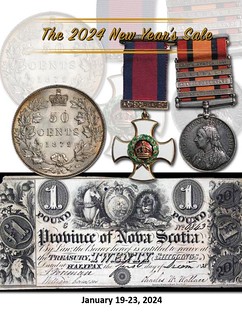 Welcome to The 2024 New Year's sale event. This auction of more than 2,200 Numismatic & Militaria lots features three major collections joined by selections from over 62 other consignors across North America.
Welcome to The 2024 New Year's sale event. This auction of more than 2,200 Numismatic & Militaria lots features three major collections joined by selections from over 62 other consignors across North America.
The first three sessions are highlighted by three attractive coin, banknote and war medal collections. The Brown
collection of Canadian banknotes Part II, The Little Collection Part VIII
of Canadian coins, The Militaria
Collection Part I
of War medals and other related items.
The Militaria
Collection holds a premium selection of carefully chosen elusive war medals of Canada and
Great Britain issues. Also featuring in this auction; a possibly UNIQUE Nova Scotia Treasury note dated 1838, an
elusive 1932 50 cents in Mint State-64. An amazing 1872H 50 cents in Mint State-63 graded by PCGS, a stunning
and tied for finest known 1889 25 Cents in Choice Mint State-64, a very beautiful 1931 5 Cents in Gem Specimen-67.
A rare 1885 5/3 (small 5/5) 5 cents in Choice Mint State-63. A great 1935 $25 Binary/Repeater with serial number
A010101 in Choice About Uncirculated-58 condition, a Unique Trial 1912 $5 Back Proof DC-21CT with Green colour
in Choice About Uncirculated-55. A rare 1935 $5 French text with serial number #A000010 in Choice condition, a
stunning 1954 $1000 BC-44c in Gem Uncirculated. A lovely set of 1973 $1 with low serial numbers and a complete
Set with solid numbers.
In addition, Two Jewels in this sale are The Canadian Bank of Commerce Trinidad 1921 $5 Low serial #00029 Choice Very Fine-30 and the Prince Edward Island 5 Shillings Holey Dollar, PCGS Genuine VG Details, Faulkner-C.7, Mon 1792-Mo FM 8R Fineberg.
In session 4, you will find a nice assortment of tokens, US, World coins & banknotes. In session 5, you will find over 500 lots of Canadian coins, banknotes and bulk lots.
This fantastic 2024 New Year's Sale event should make some spectacular moments and active evenings of auctioning. We expect this to be one of the most prestigious numismatic online events of 2024 featuring several rarities never offered to the public.
Our sincere thanks to the consignors for entrusting us with the fantastic task of selling their collections. We hope you enjoy this catalogue as much as we enjoyed making it. This should be a memorable sale!
Happy and Prosperous New Year
For more information, or to bid, see:
https://auctions.canadiancoinsandpapermoney.com/auction/223/the-2024-new-years-sale-major-sale
NUMISMATIC NUGGETS: DECEMBER 17, 2023
Here's a selection of interesting or unusual items I came across in the marketplace this week. Tell us what you think of some of these. -Editor
Persian Hairpin Money
Lot 603. Persian, Safavid Empire. 1501-1736. AR larin (hairpin money). Rare.
Larins (hairpin money) were produced sometime during the 16th to 18th centuries. They are thin strips of silver bent double and clipped, and then stamped with inscriptions.
From the December 19, 2023 Agora Auctions sale. -Editor
To read the complete lot description, see:
Lot 603. Persian, Safavid Empire. 1501-1736. AR larin (hairpin money). Rare.
(https://agoraauctions.com/doc/listing/viewdetail/58016)
Dutch East Indies Plantation Token
DUTCH EAST INDIES - PLANTATION TOKEN: c.1906-09 copper plantation token, inscribed 'VEREENIGDE HEVEA PLANTAGEN/DER/BILA-LANDEN/SUMATRA/O.K.'; VF.
From Leski Auctions Pty Ltd in Australia. -Editor
To read the complete lot description, see:
Lot 329: Indonesia Coins: DUTCH EAST INDIES - PLANTATION TOKEN: c.1906-09 copper plantation token, inscribed 'VEREENIGDE HEVEA PLANTAGEN/DER/BILA-LANDEN/SUMATRA/O.K.'; VF.
(https://www.invaluable.com/auction-lot/Indonesia-Coins:-DUTCH-EAST-INDIES-PLANTATION-T-329-c-AF943A1AC6)
Double Denomination Error
1964 1C Lincoln Cent -- Double Denom on Struck 10C -- MS66 PCGS. Ex: Fred Weinberg Collection. PCGS Population: (0/0). NGC Census: (3/0). Mintage 2,652,525,762.
Great error from the Fred Weinberg Collection. Offered by Heritage. -Editor
To read the complete lot description, see:
1964 1C Lincoln Cent -- Double Denom on Struck 10C -- MS66 PCGS. Ex: Fred Weinberg Collection. NGC ..
(https://coins.ha.com/itm/errors/1964-1c-lincoln-cent-double-denom-on-struck-10c-ms66-pcgs-ex-fred-weinberg-collection-ngc/a/60351-52033.s)
First Powered Flight Medal
This one sold years ago, but I found it when I went looking for numismatic items featuring today's date, the anniversary of Wilbur and Orville Wright's first flight. -Editor
To read the complete lot description, see:
Wilbur and Orville Wright - First Powered Flight - December 17, 1903 Commemorative Coin/Medal
(https://www.propertyroom.com/l/wilbur-and-orville-wright-first-powered-flight-december-17-1903-commemorative-coinmedal/12985260)
From The Writer's Almanac:
"On this day in 1903, Wilbur and Orville Wright took off on the world's first airplane flight near Kitty Hawk, North Carolina. This day in 1903 began with gray skies and sharp wind. Orville said years later that he should have realized it was much too dangerous to fly in that weather. But they had already waited several days for the right flying conditions, and they wanted to get home before Christmas.
"Orville went first and he got about 10 feet off the ground, and landed almost immediately. The brothers made two more attempts, and still they barely got anywhere. Then Wilbur tried again, and suddenly, he took off into the air. He flew straight into the wind for nearly a full minute, covering 852 feet. When he landed, the rudder frame was cracked, which would take months to repair, but they had made their first successful flight.
"No journalists attended the event. The Wright Brothers hired an amateur photographer to take a single photograph that day, which he did while the plane was only 10 feet off the ground. When it leaked to the press, most major newspapers refused to run the story, assuming that it was a hoax. It wasn't until Wilbur flew a plane over Manhattan six years later that most people finally accepted the fact that the Wright Brothers really had invented the first airplane."
To read the complete article, see:
The Writer's Almanac from Sunday, December 17, 2006
(https://thewritersalmanac.substack.com/p/the-writers-almanac-from-sunday-december-134)
SPANISH COLONIAL CUARTILLOS
An article by Stack's Bowers Numismatist and Cataloger Gabriel Solares published an article about the Emilio M. Ortiz collection of Spanish colonial Cuartillos. -Editor
The Stack's Bowers Galleries January 2024 NYINC Auction will be offering a specialized catalog featuring Emilio M. Ortiz's landmark collection of Spanish colonial Cuartillos. Many incredibly elusive cob issues and conditional rarities will headline the sale, so specialists in the series should be sure not to miss this opportunity.
Valued at just 1/4 Real but typically still struck in fine silver, the Cuartillo circulated extensively across all rungs of the social hierarchy of Spanish America. Owing to the coin's diminutive size, mint workers could not simply miniaturize the 8 Real designs as they had done for the other minor denominations. Consequently, some of the most interesting, creative, and enigmatic designs of the Spanish colonial series are found exclusively on the humble Cuartillo. The wars of independence that erupted in the early 19th century give us some of the most individual and elusive issuances of the Cuartillo, pieces that foreshadow the rich numismatic output of the early post-colonial republics.
Some highlights of the collection include multiple early Cuartillos struck under the famed assayer Alonso Rincon in the Lima and Potosi mints. The distinctive cob Cuartillos of Bogota are well-represented, as are the elegant milled issues of Santiago. Elite examples of the challenging War of Independence issues from Venezuela and Mexico are certain to excite collectors. An enigmatic 1822 Cuartillo from Guatemala will also be making a rare auction appearance.
The entire January 2024 auction of the Emilio M. Ortiz Collection is available for viewing and presale bidding at StacksBowers.com. For information about receiving a printed catalog call 800-458-4646 or email Info@StacksBowers.com. The collection will be auctioned live in New York City on January 12, 2024, as part of our official New York International Numismatic Convention Auction.
Here are some lots that caught my eye. Interesting little coins. -Editor
COLOMBIA. 1/4 Real, ND (ca. 1771-72). Santa Fe de Nuevo Reino (Bogota) Mint. Charles III. NGC MS-62.
EMO-143.3 (Plate coin); KM-A30; Cal-159 (for Charles IV); Restrepo-2.1 (for Ferdinand VI). Variety with lion's tail curled outward. A beautiful example resounding with much luster. The wide castle and rampant lion offer crisp definition with a frosty finish. Flashes of electric blue further amplify the coin's eye appeal.
To read the complete lot description, see:
COLOMBIA. 1/4 Real, ND (ca. 1771-72). Santa Fe de Nuevo Reino (Bogota) Mint. Charles III.
(https://auctions.stacksbowers.com/lots/view/3-17BERW/colombia-14-real-nd-ca-1771-72-santa-fe-de-nuevo-reino-bogota-mint-charles-iii-ngc-ms-62)
VENEZUELA. Caracas. 1/4 Real, 1805. Caracas Mint. Charles IV. NGC EF-45.
EMO-253.1 (Plate coin); KM-C2; Cal-6 var. (regular denomination); Stohr-2. Already an EXTREMELY RARE type, the present example is the only one found in CoinArchives with the "4" in the denomination shown correctly and not in retrograde. This issue is almost never found in such a wholesome state, unmarred by corrosion. As such, all of its details including the date, city name, central devices, and denomination appear boldly on the handsome brown surfaces. An exceptional coin worthy of strong bids by Venezuelan specialists.
To read the complete lot description, see:
VENEZUELA. Caracas. 1/4 Real, 1805. Caracas Mint. Charles IV. NGC EF-45.
(https://auctions.stacksbowers.com/lots/view/3-17BF6S/venezuela-caracas-14-real-1805-caracas-mint-charles-iv-ngc-ef-45)
VENEZUELA. Puerto Cabello - Caracas. 1/4 Real, ND (1823). NGC VF-30; Countermark: EF Standard.
EMO-262 (Plate coin); cf. KM-C-2 (for undertype); cf. Cal-63 (same); Stohr-RI.24. Issued by decree of 4 June 1823, repealed by decree of 14 March 1826. Countermark: Nonsensical raised "Chinese" inscription within indent, applied to the obverse of an 1814 Caracas Royalist 1/4 Real. A delightful example bearing a clear view of all pertinent detail on the host coin as well as the counterstamp. Toned to a deep even black with a glossy finish, it makes a lovely representative for this host date.
To read the complete lot description, see:
VENEZUELA. Puerto Cabello - Caracas. 1/4 Real, ND (1823). NGC VF-30; Countermark: EF Standard.
(https://auctions.stacksbowers.com/lots/view/3-17BFPA/venezuela-puerto-cabello-caracas-14-real-nd-1823-ngc-vf-30-countermark-ef-standard)
COLOMBIA. Cartagena. Cob "1/4 Real", ND (ca. 1813-15). Salazar de las Palmas Mint. Ferdinand VII. NGC AU-58.
EMO-308.1 (Plate coin); cf. KM-B8 (for prototype); cf. Cal-325 (same). Weight: 0.62 gms. An EXTREMELY RARE royalist issue imitating the 1/2 Reales of Philip V. Clipped down to a weight somewhere between a Cuartillo and a Mitad (or 1/8 Real), its tiny planchet displays just the king's monogram on one side and the center of the cross on the other. The coin remains in a highly impressive state of preservation despite its crude nature. The surfaces are free of any corrosion or damage, instead displaying their distinctly imitative design quite boldly along with lovely cabinet gray tone.
To read the complete lot description, see:
COLOMBIA. Cartagena. Cob "1/4 Real", ND (ca. 1813-15). Salazar de las Palmas Mint. Ferdinand VII.
(https://auctions.stacksbowers.com/lots/view/3-17BFRL/colombia-cartagena-cob-14-real-nd-ca-1813-15-salazar-de-las-palmas-mint-ferdinand-vii-ngc-au-58)
To read the complete article, see:
A LANDMARK OFFERING OF SPANISH COLONIAL CUARTILLOS FROM THE EMILIO M. ORTIZ COLLECTION
(https://stacksbowers.com/a-landmark-offering-of-spanish-colonial-cuartillos-from-the-emilio-m-ortiz-collection/)
AUSTRALIA RELEASES NEW $1 KING CHARLES COIN
Don Cleveland passed along this article about Australia's new Charles III coins. Thank you. -Editor
 The first Australian coins featuring King Charles' head on them are now in circulation across the country, joining the millions featuring his late mother Queen Elizabeth.
The first Australian coins featuring King Charles' head on them are now in circulation across the country, joining the millions featuring his late mother Queen Elizabeth.
The effigy of King Charles III will feature on the new $1 coins being manufactured by the Royal Australian Mint.
The first batch of 3.5 million coins have been delivered to the banks and will join the coins featuring the effigy of the late Queen Elizabeth II, which will continue to remain in circulation.
Under a tradition dating back to at least the 17th century, successive monarchs face in different directions on the coins. Queen Elizabeth II faced to the right.
King Charles III now faces to the left.
The coin was designed by the Royal Mint in London, with the effigy getting the approval of the royal family.
The remaining denominations of circulating coins will be released progressively in 2024, based on bank demand.
Don adds:
"I have yet to see a Charles III coin, but have been told they are out there. What other countries have released any? "
To read the complete article, see:
Australian Royal Mint releases new $1 King Charles coin into circulation
(https://www.news.com.au/finance/business/banking/australian-royal-mint-releases-new-1-king-charles-coin-into-circulation/news-story/fac2262586791413afd2946a89e3e100)
THE BOOK BAZARRE
REALLY BAD FAKE CANADIAN TOONIES
Gerry Tebben writes:
"We're all fascinated by contemporary counterfeits, especially really bad ones. Canada's Global News is reporting about some extraordinary fake $2 coins. The queen has a giant schnoz, the denomination is expressed as a dollar sign instead of the numeral 2 and the reverse legend has the word CANADA twice instead of CANADA DOLLARS.
The crook paid a nickel apiece for tens of thousands of the "coins." They're much more dramatic than the "camel toe" fake toonies that have been circulating for several years."
Thanks. These really are gawd-awful things. -Editor
An arrest and huge seizure of 26,000 allegedly counterfeit $2 coins in Quebec, and a second smaller seizure of the same dodgy coins in a northern Ontario city a few months later, suggests that a new counterfeit toonie variety is circulating across Canada, a coin expert says.
Global News learned about a new variety of fake toonie while researching the case of the Quebec man who is facing criminal charges for an alleged attempt to import more than 26,000 dodgy toonies from a coin maker in China, paying a nickel a piece for them, plus shipping, court records state.
Last week, the CBSA shared with Global News, for the first time, some digital photos of the 26,000 seized $2 coins that were allegedly ordered from China and circulated in Quebec.
At the same time, police in Sault Ste. Marie, Ont., confirmed that they arrested a local person who had a smaller number of the same counterfeit coins in their possession in March, and seized 15 coins.
Counterfeit Canadian coin expert Mike Marshall of Trenton, Ont., who examined images of both sets of seized coins for Global News, said they appear to come from the same manufacturer.
Both the Quebec and Ontario fake coins are stamped 2012.
Marshall said the new $2 fake coins do look real at first glance, but the counterfeits have several distinguishing features that ordinary consumers can spot, including:
- The Queen's nose is too sharp and long on the fake coin's head side.
- Above the Queen's head, a maple leaf-shaped security feature appears on the fake coin that does not appear on genuine toonies from 2012.
-
On the polar bear side of the fake coin, a
$
symbol appears between two maple leaf-shaped security features. On the real coin, the numeral2
actually appears in that spot. -
Also on the polar bear side, on the right side near the bear's head, the word
CANADA
appears on the fake coin. On the real coin, the wordDOLLARS
appears in that space. -
Lastly, the
2012
year on a real toonie appears in a straight line, while the same numbers appear on a curve or slight arc on the counterfeit coins.
To read the complete article, see:
A new fake Toonie has emerged in Quebec, Ontario: Here's how you spot it
(https://globalnews.ca/news/10108612/fake-toonie-quebec-ontario-how-to-spot-it/)
To read an earlier E-Sylum article, see:
COUNTERFEIT CANADIAN 'CAMEL TOE' TOONIES
(https://www.coinbooks.org/v26/esylum_v26n09a30.html)
DAVID SMITH'S MEDALS FOR DISHONOR
I wasn't familiar with this artist or series of medals which has just been acquired by Harvard Art Museums. Here's an excerpt from the press release. -Editor
The Harvard Art Museums today announce the gift of Medals for Dishonor, a critical early work by preeminent 20th-century sculptor David Smith (American, 1906–1965). The gift from the artist's estate comprises 14 cast bronze narrative reliefs from a profoundly political and satirical series that addresses anti-war and anti-fascist themes. The 15th medal in the series has been placed on long-term loan by the estate. These works join a large group of sculptures, paintings, and works on paper by Smith in the Harvard Art Museums collections. Harvard is now the only institution with the ability to show the Medals for Dishonor as a unified group.
This transformative gift allows the museums to continue to exhibit, study, and teach with these critical early works in the way that the artist himself envisioned,
said Sarah Kianovsky, who recently retired as Curator of the Collection in the Division of Modern and Contemporary Art at the Harvard Art Museums.
Kianovsky, who has published extensively on the work of David Smith, initially arranged for the loan of the medals from the estate in preparation for the reopening of the Harvard Art Museums in November 2014, after a major renovation and expansion project. The medals have been on display since then in the museums' Social Realism gallery on Level 1, where they are regularly used in university courses ranging from history to sociology and economics. They draw the curiosity and sustained attention of many general visitors as well.
Smith began work on the elaborately detailed figurative medals at the same time (1938–40) he was preparing for his first solo exhibition of abstract steel sculptures. Turning the notion of the military medal on its head, he created instead a searing examination of the causes and effects of war that was informed by his recent travels in Europe and the Soviet Union, by the political commentary in Picasso's Guernica and The Dream and Lie of Franco, and by his work in the sculpture division of the Federal Art Project of the Works Progress Administration. The texts accompanying the medals, by turns pointed and poetic, illuminate Smith's desire to maintain a critical stance toward American culture while acknowledging the moral imperative of American involvement in world events, particularly the expanding war in Europe.
Candida Smith and Rebecca Smith, co-presidents of The Estate of David Smith, said: The family of David Smith is convinced, as was the artist himself, that there is no better place for the Medals for Dishonor than the Harvard Art Museums, which contain a large collection of artworks and archival objects relating to David Smith's life and work. We are immensely gratified to know that the Medals for Dishonor, during their residency at the Fogg Museum, have been viewed regularly by art and history students alike.
The Estate of David Smith is dedicated to preserving the legacy of the artist through the promotion of exhibitions, publications, and research. The estate encourages new scholarship of Smith's work while preserving an extensive archive containing historical documents and photographs related to Smith's life and career. davidsmithestate.org
To read the complete press release, see:
David Smith's Medals for Dishonor Series Acquired by Harvard Art Museums
(https://harvardartmuseums.org/about/press-media/david-smith-s-em-medals-for-dishonor-em-series-acquired-by-harvard-art-museums)
MORE ON MEDALS FOR DISHONOR
Here's more about David Smith and his Medals for Dishonor series from the Museo Reina Sofía in Madrid. -Editor
David Smith (Decatur, Indiana, 1906-Bennington, Vermont, 1965) was one of the foremost artists of the 20th century. Smith, the sculptor most closely linked with Abstract Expressionism, revolutionized art in the United States by introducing into its sculptural idioms a rich synthesis of models pioneered in Europe by Pablo Picasso and Julio González, as well as the Surrealists, and the Russian Constructivists. Smith is believed to have created the first welded metal sculptures in America. His diverse and broadly inventive oeuvre paved the way for many of the sculptors who followed in the later twentieth century.
Between the autumn of 1935 and the summer of 1936, Smith travelled to Europe, where he enriched his artistic grounding and came face to face with the social and political tensions occurring across the old continent. He spent one month in Paris before a lengthy stay in Athens, where he was given the opportunity to explore classical art in depth. Smith also travelled to the Soviet capitals Leningrad and Moscow, where he contemplated some of the masterpieces of modern painting. Finally, while in London, he discovered the British Museum's collection of Sumerian seals with reverse carvings as well as its collection of German medals from the First World War, which were key to the formulation of the series Medals for Dishonor.
Medals for Dishonor is a series of fifteen reliefs produced between 1937 and 1940. Through them he executed a profound critique of a period marked by the far-reaching social and political consequences of the economic crisis and the onset of war. The series, exhibited at the Willard Gallery in New York in November 1940, was influenced by the sense of disappointment in humanity's regression through fascism in Europe and the injustices of world capitalism. Therefore, after the series was displayed in various US states, in December 1941 the artist told the gallerist Marian Willard that the medals reflected an anti-fascist and
pro-democratic
stance.
The entirety of Smith's artistic output is characterised by a particular engagement with the most artisanal side of the work. From the 1930s onwards he welded and soldered his own abstract pieces, combining the production of steel sculptures with the ambitious work Medals for Dishonor, on which he would work night and day.
For these reliefs Smith employed the technique used by the Sumerian seals carved in reverse - the huge demands and attention to detail in the whole process, from the preparatory drawing to the finished plaster casts, for which he even used dentist's tools, explain the time it took him to finish the series. The rigorous technique was carried over into making up the first edition of the medals in metal, a process which saw Smith work with a local jeweller.
To read the complete article, see:
Medals for Dishonor
David Smith
(https://www.museoreinasofia.es/en/collection/research-projects/david-smith)
JELONEK AWARDED WACKS JUDAICA ART MEDAL
Hanna Jelonek has won the 2023 Mel Wacks Judaica Art Medal Award. Here's the announcement. Great topic and medal. -Editor
The winner of the 2023 Mel Wacks Judaica Art Medal Award for the best medal shown at FIDEM featuring a Judaic or biblical theme was Hanna Jelonek for her homage to "The Warsaw Ghetto Uprising by sculptor Nathan Rapoport, installed in Warsaw and Yad Vashem, Jerusalem. The medal commemorates the 80th anniversary of the Warsaw Ghetto uprising, led by the youthful Mordecai Anielewicz, who is portrayed by Jelonek and Rapoport as a more mature man.
The uprising was the largest single revolt by Jews during World War II; a total of 13,000 Jews were killed. According to the United States Holocaust Memorial Museum, the uprising was "one of the most significant occurrences in the history of the Jewish people."
 The award-winning medal was commissioned by the Association of The Jewish Historical
Institute of Poland. A short video showing the creation of Jelonek's medal can be seen at
https://youtu.be/t7Tozs4OwKk.
The award-winning medal was commissioned by the Association of The Jewish Historical
Institute of Poland. A short video showing the creation of Jelonek's medal can be seen at
https://youtu.be/t7Tozs4OwKk.
Hanna Jelonek received an engraved silver ingot from the Jewish-American Hall of Fame and $250 from the Hebrew Union College's Skirball Museum in Cincinnati.
THAT'S NOT SANTA CLAUS
Pete Smith submitted this timely piece inspired by last week's item picturing a banknote from his home town of New Ulm, Minnesota. -Editor
I enjoyed seeing the banknote issued by the Central Bank of New Ulm. I believe that is not a vignette of Santa Claus. Let me tell you why.
You are probably familiar with the poem, Night Before Christmas by Clement Moore first published in 1823. The actual title is A Visit from St. Nicholas. The poem never mentions Santa Claus.
This may be hard for some readers to accept. When the St. Nicholas Bank issued bank notes in 1853 with a jolly man, his sleigh and reindeer, it was not a vignette of Santa Claus. It was a vignette of St. Nicholas.
The town of New Ulm was settled by German immigrants in 1854. By 1861, the language heard in the town was more likely to be German than English. The town would have celebrated a visit from St. Nicholas or perhaps Sinterklaas.
I grew up in New Ulm. I listened to men speaking German in the barbershop. By the 1950's, St. Nicholas Day was still part of the town culture. On the eve of St. Nicholas Day, my boy scout troop went around with our scoutmaster to visit homes and ask children what they wanted for Christmas.
The American image of Santa Claus dates back to a cartoon by Thomas Nast published in 1863. I believe that bank note vignettes dated before that time should be attributed to St. Nicholas. Our modern image of Santa Claus was influenced by Coca Cola staring in 1931.
In 2020, the ANA Money Museum published an article on St. Nicholas bank note illustrations. I believe they got it right.
There is some question if Central Bank notes actually circulated in New Ulm. There is speculation that the notes were passed in Minneapolis and St. Paul by people who never visited New Ulm off in the frontier.
Can any E-Sylum reader explain why the Central Bank in New Ulm closed in 1862?
Good point - thanks for keeping us honest. Three cheers for Saint Nick! Can anyone tackle Pete's question about the 1862 bank closure? -Editor
To read the earlier E-Sylum article, see:
SANTA CLAUS ON THE NEWMAN NUMISMATIC PORTAL
(https://www.coinbooks.org/v26/esylum_v26n50a07.html)
TOM BADLEY'S BITCOIN BANKNOTES
Designer Tom Badley has created a set of bitcoin banknotes. -Editor
Fusing the digital and tangible to transform cryptocurrency into a physical form, Tom Badley introduces a family of banknote-like bearer instruments, capable of holding and transmitting Bitcoin. The London-based designer's concept for Bitcoin Banknotes has been a persistent idea since the inception of cryptocurrency in 2009, drawing a connection to traditional monetary structures. The vibrant design of the notes celebrates the novelty, volatility, and contrarian nature of its namesake through a modernist, aspirational, and affirmative approach. Recognizable visual elements such as logos, flags, moons, and the Genesis Block hash find a place in the design lexicon. However, given Bitcoin's faceless nature, a classical heads motif reminiscent of Hellenistic deities was introduced to instill a sense of trust, a crucial element in currency design. Nodding to Bitcoin's association with ‘moon money', each deity on the banknotes also wears an astronaut's suit, and the rim of the helmet collar helps to frame the heads.
Bitcoin, with its roots in the word ‘coin,' has long been visually associated with existing forms of money; even early logo iterations embraced the familiar imagery of coins. Tom Badley's concept of the Bitcoin Banknote extends the cryptocurrency's reach into the realm of cash, emphasizing the significance of paper wallets as Bitcoin's offline storage medium. ‘Paper and private Bitcoin thus share a common domain. Many paper wallets have assumed the form of ‘play money', vouchers, or simple banknotes, to embellish them with the feel of money. This has always fallen short, because the creators of these paper wallets did not use the secure printing techniques used in banknote production – until now…' notes the designer.
Offline.Cash tasked the Badley with creating a family of four banknotes, each functioning as private, individual wallets with fixed Bitcoin values stored on scannable chips that allow cryptocurrency to be reliably transacted in cash form. The goal of Offline.Cash was two-fold: first, to captivate existing cryptocurrency enthusiasts, the ‘hodlers,' and second, to provide a reliable means of transacting Bitcoin in cash where traditional currency might be scarce, aligning with Bitcoin's humanitarian role. The banknotes are printed on a durable plastic substrate, employing high security printing processes including intaglio, the raised printing commonly found on traditional banknotes. This level of production marks them as a ‘world first' in mass-produced Bitcoin wallets meeting banknote standards.
The design brief mandated a paradoxical balance between delight and gravitas, capturing the mystique of both early Cassacius coins and the origins of Bitcoin. The main design limitation was that the notes would be printed on the same sheet, together, using a six-color process, requiring careful consideration of design and workflow to maximize the limited color combinations available. The use of light and bright colors enhances visual appeal and differentiation, diverging from the conservative color palette of centralized money. The impressionistic design approach, necessitated by the printing limitations, imparts a seamless blend of colors, creating an illusion of separate printing and a rounded edge finish.
For more information, see:
https://offline.cash/
https://tombadley.net/
Physical cryptocurrency banknotes are not new - earlier we've discussed products of the Noteworthy company as well bitcoin-banknote.com. which seems to be associated with offline.cash. Both firms were founded in 2021. These notes seem nicely done, and the cross-Atlantic competition is a sign that there may be some life to this market. Time will tell if these ever jump to the mainstream or remain relegated to the collectible market. -Editor
To read the complete article, see:
FUSING DIGITAL AND TANGIBLE MONETARY REALMS
(https://www.designboom.com/design/bitcoin-banknotes-tom-badley-cryptocurrency-12-15-2023/)
To read earlier E-Sylum articles, see:
TOM BADLEY'S PORTFOLIO OF MONEY
(https://www.coinbooks.org/v22/esylum_v22n32a34.html)
BITCOIN BANKNOTES
(https://www.coinbooks.org/v24/esylum_v24n11a32.html)
NOTEWORTHY ISSUES 0.005 BITCOIN NOTE
(https://www.coinbooks.org/v26/esylum_v26n50a29.html)
LOOSE CHANGE: DECEMBER 17, 2023
Here are some additional items in the media this week that may be of interest. -Editor
Bob Julian published a nice history of the Susan B. Anthony Dollar in Numismstic News. Here's a short excerpt - see the complete article online. -Editor
In one of those odd happenings that liven up numismatic history, a coin dealer managed to get a few hundred Anthony dollars in advance of the official release date, no doubt with the help of a friendly banker. The Treasury, apparently believing that this was a heinous crime of the worst kind, made a real effort to prosecute the hapless individual. Although the net result was the usual great waste of money and time, in truth, they should have given the coin dealer a medal for at least helping to popularize the new coin.
In due course, the coins, after a huge publicity campaign mounted at taxpayer expense, were duly released and were met with reactions ranging from a loud yawn to outright hostility. This was followed by laughter on a grand scale as the public realized the magnitude of the blunder. It was not long before the most commonly heard name for the new coin was the Agony Dollar,
a play on words that reflected the unnecessarily stern look on Miss Anthony's face.
Shortly after this, and to prove some strange political point, Senator William Proxmire of Wisconsin forced through the Senate a ban on further coinage of the Anthony dollars until his demands were met. They soon were, and coinage resumed. Proxmire was once famous for handing out awards to bureaucrats for wasting money but was singularly quiet when it came to his part in this coinage disaster.
To read the complete article, see:
The Susan B. Anthony Dollar
(https://www.numismaticnews.net/collecting-101/the-susan-b-anthony-dollar)
As Superintendent of Finance for the Confederation, Robert Morris is closely associated with the Nova Constellatio patterns of the 1780s. A short article by Stack's Bowers Numismatist Chris Bulfinch looks at Morris' stint in debtor's prison. -Editor
Morris, caught up in speculative land schemes and saddled with other debts in the 1790s, declared bankruptcy in 1797 amid a significant economic downturn. He entered the Prune Street Debtors' Apartment, next to the Walnut Street Prison, in February 1798. He remained there until released in October 1801 under the terms of the Bankruptcy Act of 1800. George Washington and other Revolution-era notables visited Morris in debtors' prison, underscoring Morris' influence; some historians contend that some of the political will to pass the Bankruptcy Act of 1800 was a product of Morris' imprisonment.
Morris' financial proposals and the Nova Constellatio patterns are not his only connections to U.S. numismatics. His portrait appears on $1,000 Legal Tender Notes in the 1860s and $10 Silver Certificates in the late 1870s, early 1880s.
To read the complete article, see:
DID YOU KNOW THAT EARLY AMERICAN FINANCIER ROBERT MORRIS SPENT ROUGHLY TWO YEARS IN DEBTORS' PRISON?
(https://stacksbowers.com/did-you-know-that-early-american-financier-robert-morris-spent-roughly-two-years-in-debtors-prison/)
Roger Burdette published a CoinWeek article answering reader questions about coin production at the U.S. Mint. Here's an excerpt - see the complete article online. -Editor
Who or what determines the mintage size? Time, bullion on hand, a superintendent's orders for 3,844,000 coins one year and 1,766,000 the next?
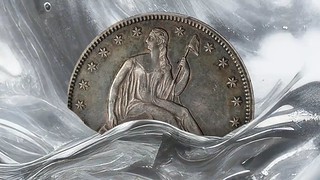 First, the Treasury Department and the Mint operated on the Federal Government's fiscal year, so that is how all the officers looked at coinage. That meant that a calendar year, as required for dating coins, was an exception to all normal accounting. This is the main reason for inconsistency in coin production from one calendar year to another: the fiscal year was more important.
First, the Treasury Department and the Mint operated on the Federal Government's fiscal year, so that is how all the officers looked at coinage. That meant that a calendar year, as required for dating coins, was an exception to all normal accounting. This is the main reason for inconsistency in coin production from one calendar year to another: the fiscal year was more important.
There were several ways used to determine how many coins were needed. For copper coins made from 1793 through 1857, demand from large cities and regions filtered its way through the largest banks and the United States Treasurer to the U.S. Mint at Philadelphia. The Mint, in turn, ordered planchets from suppliers, mainly Boulton and then Crocker Bros. Early coppers, and the later base metal minor coins, were also very profitable for the Treasury.
Gold and silver coins were made to the demand of depositors rather than for Government account. Production was erratic and depended on banks and deposits from specie brokers and the denominations of coin they requested...
To read the complete article, see:
Coin Production at the US Mint: Questions and Answers
(https://coinweek.com/coin-production-united-states-mint-questions-answers-roger-burdette/)
MONEY MEASUREMENT MANIA
A couple of articles in the popular press this week included actual and theoretical depictions of the dimensions of large amounts of money in their physical forms. This one from the Wall Street Journal interviews a maker of stage money, the fake prop cash used in theater and movie performances. -Editor
Juan Amaya has done hundreds of millions of dollars in cash business—fake dollars, that is.
Amaya runs Prop Movie Money, a business in Miami that makes look-alike bills for film and TV productions. His company's products have starred in the Fast & Furious
franchise and shows such as Billions.
Makers of prop money alter visual details such as Benjamin Franklin's portrait to prevent it from being seen as counterfeit currency. Still, the result is pretty convincing.
A million bucks doesn't look like much
Two shoeboxes—that is roughly how big $1 million in $100 bills is when stacked up, Amaya said.
He first learned how puny seven figures can seem when he and his co-workers started the company. They put $1 million of cash, in fake bills, on a table in the office as an inspiration for their new venture.
I was a little disappointed,
Amaya said. I remember thinking that a million dollars was going to be from the floor to the ceiling, just covering up a room with money. And that was not the case at all.
He added that being around fake cash all the time made money a less taboo topic of conversation between him and his co-workers.
The majority of real dollars aren't physical, and we never get to touch much of what we spend. Money doesn't take up space the way it used to, its size and shape less prominent.
Maybe movie money has a place offscreen - a legal one helping people visualize their finances and financial goals. -Editor
Amaya said he and some of his colleagues use their product as a visual aid while working on their personal budgets.
In Amaya's case, he and his fiancée set up stacks of prop money to visualize their monthly expenses, with piles representing groceries and rent.
Seeing it is far better than just writing it on a notepad or keeping it on a spreadsheet,
he said. When you see numbers on a screen, it does not have the same impact.
The exercise has prodded Amaya to put more money into savings each month. When he saw the pile representing their bank accounts, he remembers thinking, I'd like this to be a little bit taller.
Might not be too late to order some stocking-stuffers for your budget-challenged friends and relatives... -Editor
To read the complete article (subscription required), see:
Printing Millions in Fake Cash Made Them Better Money Managers
(https://www.wsj.com/personal-finance/money-advice-from-the-people-who-print-millions-in-fake-cash-for-the-movies-a45398bd)
At the other end of the spectrum, a completely non-numismatic Washington Post article provides some interesting back-of-the-envelope estimates of the physical reach of a lot of one dollar bills. The results would be very different (duh, two orders of magnitude smaller) with hundred dollar notes - an exercise left for the reader. -Editor
If we were to head to our local Bank of America and ask for $936 million in ones — perhaps giving the branch a heads-up on our request, just as a courtesy — the result would be a stack of bills that soared more than 63 miles into the sky. The boundary between Earth's atmosphere and space, known as the Karman line, sits 62 miles above Earth's surface. So our stack of Trump penalties would extend 1.6 miles into space.
If we were instead to lay those bills end to end, they would wrap around the entire planet. And wrap around it again. And again. And then wrap around it nearly two-thirds of the way yet again.
Of course, you'd have a bit of a problem just moving the bills around. The total would weigh about as much as 2½ Boeing 747s fueled for takeoff.
To read the complete article, see:
The high costs of election denial
(https://www.washingtonpost.com/politics/2023/12/16/high-costs-election-denial/)
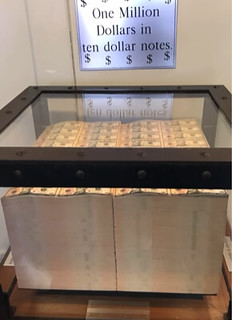
And then there's this recent Instagram reel from Stack's Bowers showing a million dollars in ten dollar bills. -Editor
To watch the reel, see:
https://www.instagram.com/reel/C0zrq6juOYc/?igshid=MTc4MmM1YmI2Ng%3D%3D
FEATURED WEBSITE: PROP MOVIE MONEY
This week's Featured Web Site is the producer of prop movie money featured in an earlier article in this issue.
While producing our first feature film over ten years ago, we realized we needed high-quality prop money. We couldn't find any, so we made our own. Created by filmmakers for filmmakers, your production DESERVES the BEST money props. Prop Movie Money has become the industry standard for quality props and the #1 trusted source for prop money for Hollywood, the entertainment industry, and storytellers worldwide.



